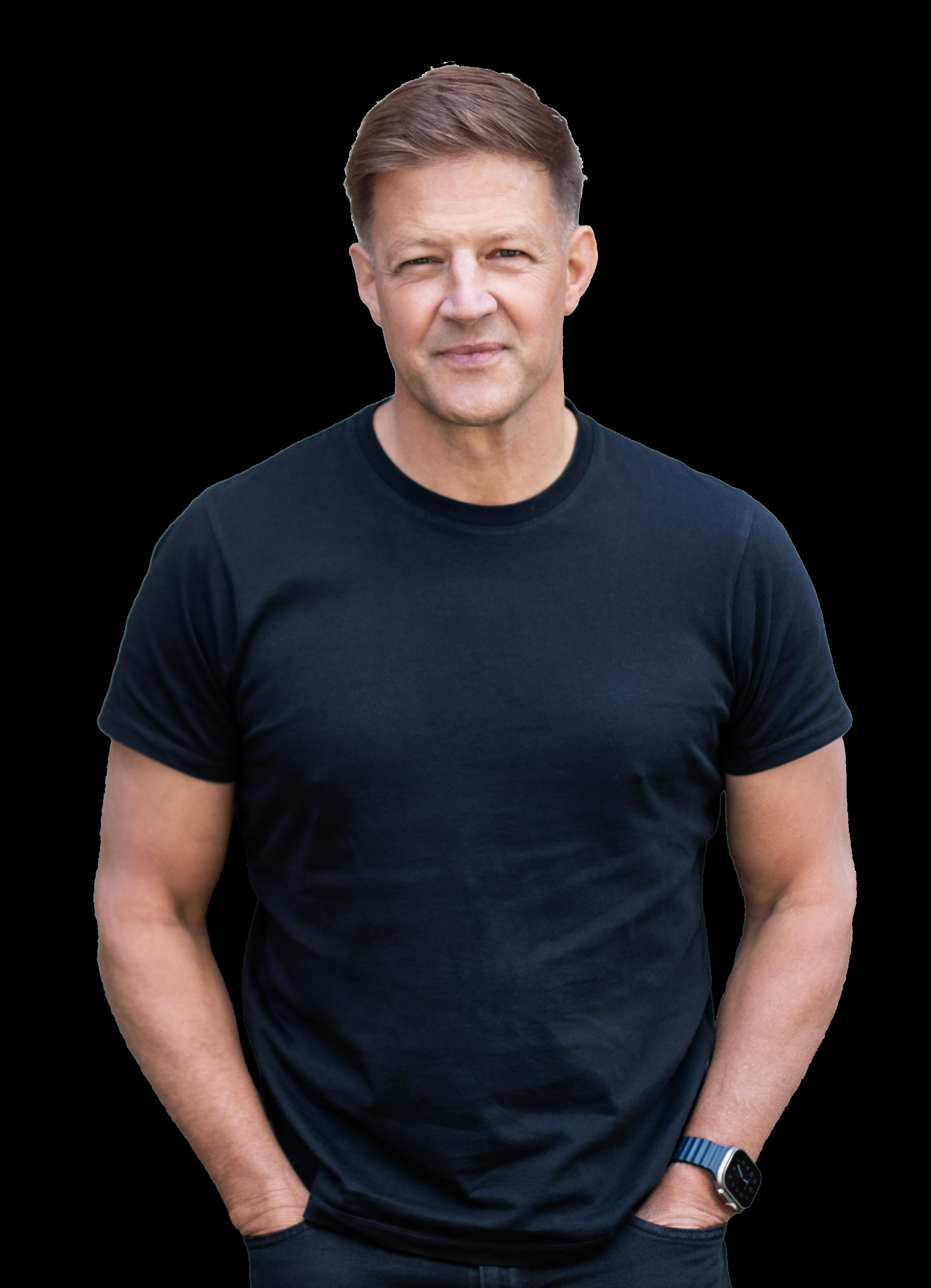
You’ve been lied to … about the AI bubble
RICHARD MULHOLLAND


You’ve been lied to … about the AI bubble
RICHARD MULHOLLAND





Dear Reader,
As we head into the final stretch of the year, we bring you an edition that could not be more relevant. The digital revolution is not just on the horizon; it is already shaping the way we live, work and grow. In this issue, we explore what it means to build a business in a world driven by rapid innovation, shifting technology and new ways of thinking.
Our theme, Decoding Digital: The New Rules of Business, examines how today’s leaders are navigating a landscape that demands adaptability, creativity and a strong sense of purpose. From the rise of AI to the reinvention of customer experiences, this edition is your guide to understanding what is now and what is next.
We are especially proud to feature Bob Skinstad on our cover. If you grew up in the 90s and 2000s, you will likely have fond memories of Bob, even if you were not a big rugby fan. Known for his electric presence both on and off the field, Bob’s evolution into a strategic business thinker and media personality is a story of reinvention and relevance. His insights

are as energising as his sporting highlights.
We are also excited to welcome Kalnisha Singh, our newest contributor, who offers a powerful perspective on workplace sustainability. Her voice adds a fresh layer to this edition's theme and challenges us to think long-term.
Returning to our pages is the always insightful Nomfundo Mabaso, whose ongoing column on legal matters in business continues to provide clarity and confidence to business owners navigating legal complexity.
Together with our wider community of contributors, this edition is packed with real-world insight, future-ready thinking and a strong undercurrent of optimism. Because even in a fast-changing world, one thing remains constant: the power of knowledge, connection and bold ideas.
Warmly, Lisa Bell Editor-in-Chief WORD Magazine





How Business has Changed Forever
Kim du Plessis
35 THE COLLAB COLLECTIVE
Why the Flexible Office is the New Rule of Business Strategy WeWork
38 POSITIVE VIBES
Powered by People, Not Platforms
Andre du Toit
42 COACH ME!
Let’s Get the Ego Back in the Room
George Eadie
46 BEHIND THE PRODUCTIONS
Producing from Inpact: Creativity Meets Digital Evolution
Rhoda and Alfonso Stoffels
50 A LAW UNTO HERSELF
Striking the Balance: Regulatory Framework, Corporate Governance and the Rise of Artificial Intelligence and Legal Technologies
Nomfundo Mabaso
53 ADD TO FAVES
55 ECHOES OF AI
Decoding Digital: The New Rules of Business Nova Quinn
58 THE DIGITAL PULSE
The Algorithm Shift: Why Listening to Your Audience Matters More Than Beating the Feed
Ashleigh Easthorpe
61 KREATIVELY YOURS
Designing In a World that Updated Itself
Krystin Morgenrood
62 HEALTHY HABITS HUB
Decoding Digital Dumbbells: The New Rules of Sweat
Ruan Retief
64 LEAD WELL
Decoding Digital Leadership: Thriving
Under the New Rules of Business
Dr Kerryn Powell and Werner Koen




67 THE GREEN SCENE Green Tech, Real Impact: How Digital Tools Are Powering the Sustainability Movement Lisa Bell
Building futures through opportunity, dignity and purpose.

The Chose Choeu Foundation is dedicated to transforming lives through skills development, community upliftment, and youth empowerment. We believe that every individual deserves the chance to rise, with the right tools, training, and support.

Support programmes that equip youth and women with practical skills to secure employment or start businesses. chosec.org info@chosec.org
Help fund educational resources, mentorship, and training to inspire future leaders.

Partner with us to build sustainable communities and social impact initiatives.

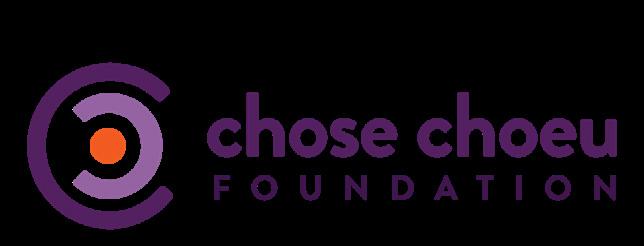

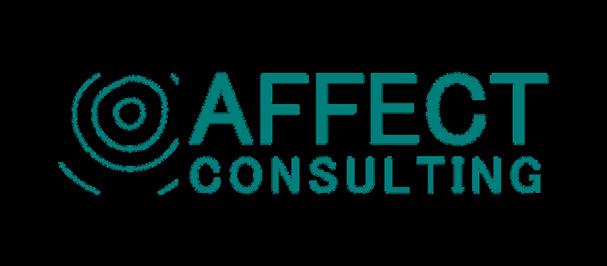

Affect Consulting par tners with business owners and managers to dr ive strategic growth through balanced leadership, leading your business, yourself, and your team more effectively.

Central to sustainable success is the har mony between your financial health, leadership effectiveness, and team productivity Our proven systems-thinking approach helps you identify strengths, close gaps, and activate your next phase of growth




Author Kevin Chaplin
Managing Director - SA Ubuntu Foundation & the Amy Foundation

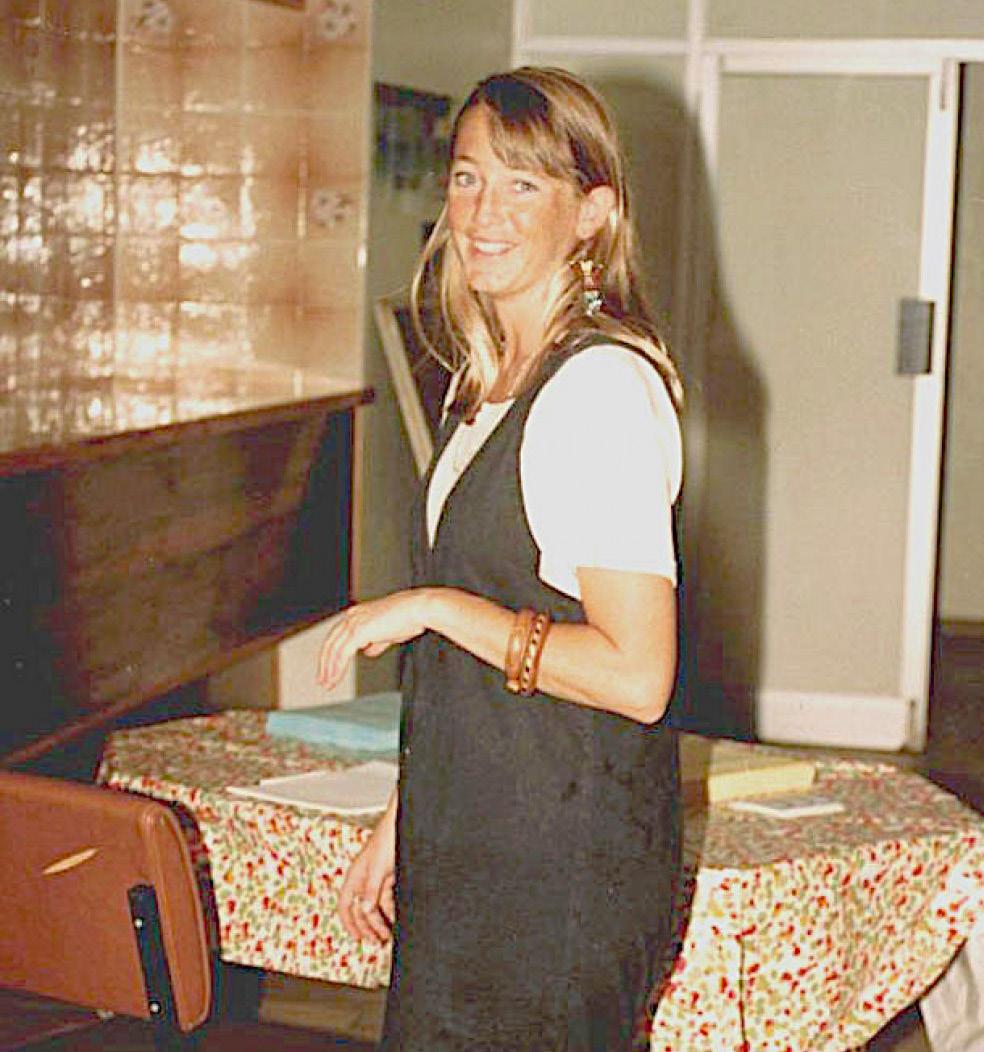
The Amy Foundation gathered at the Amy Biehl Memorial Site in Gugulethu to honour the life and legacy of Amy Biehl, the 26-year-old American Fulbright scholar whose life was tragically cut short in Gugulethu on 25 August 1993.
In an act that continues to move and inspire the world, Amy’s parents, Linda and Peter Biehl, chose the path of forgiveness and reconciliation after her death. They not only
forgave those responsible but went on to work alongside them, building a foundation rooted in hope, healing, and opportunity. Today, one of those men, Ntobeko Peni, is a respected leader within the Amy Foundation, working daily to mentor, guide, and empower the next generation.
On this 32nd anniversary, Linda Biehl and Ntobeko Peni laid down flowers at Amy’s memorial site in Gugulethu, symbolising a bond of forgiveness that has turned tragedy
As part of the commemoration, learners from the Siyazingisa After School Programme in Gugulethu showcased their talents, demonstrating the creativity, energy, and potential that Amy so passionately believed in. These young voices are the living embodiment of her dream for a brighter, more inclusive South Africa.
Since its founding in 1998, the Amy Foundation has reached over 12000 young people, equipping them with skills, values, and opportunities to break cycles of poverty and build meaningful futures. Every learner supported is a reminder that from pain can come purpose, and from loss, the power to change lives.
“This is more than a day of remembrance; it is a celebration of forgiveness, reconciliation, and the remarkable journey of transformation that Amy’s story has made possible,” says Michelle Bagley, COO of the Amy Foundation. “We are honoured to continue her legacy through every child we serve.”
The Amy Foundation invites all South Africans to reflect on Amy’s story, one of the most profound examples of reconciliation in our country’s history and to continue working together to uplift and empower the youth who represent our shared future.
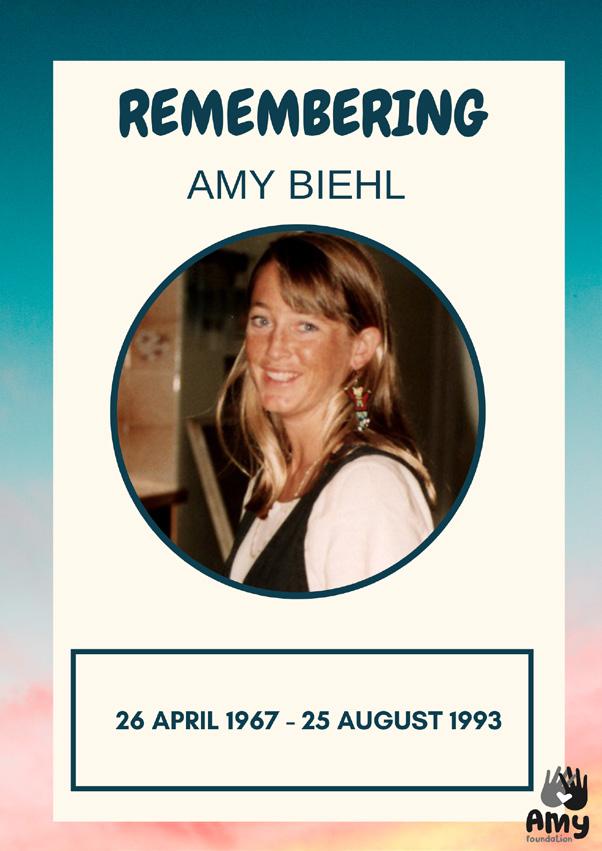
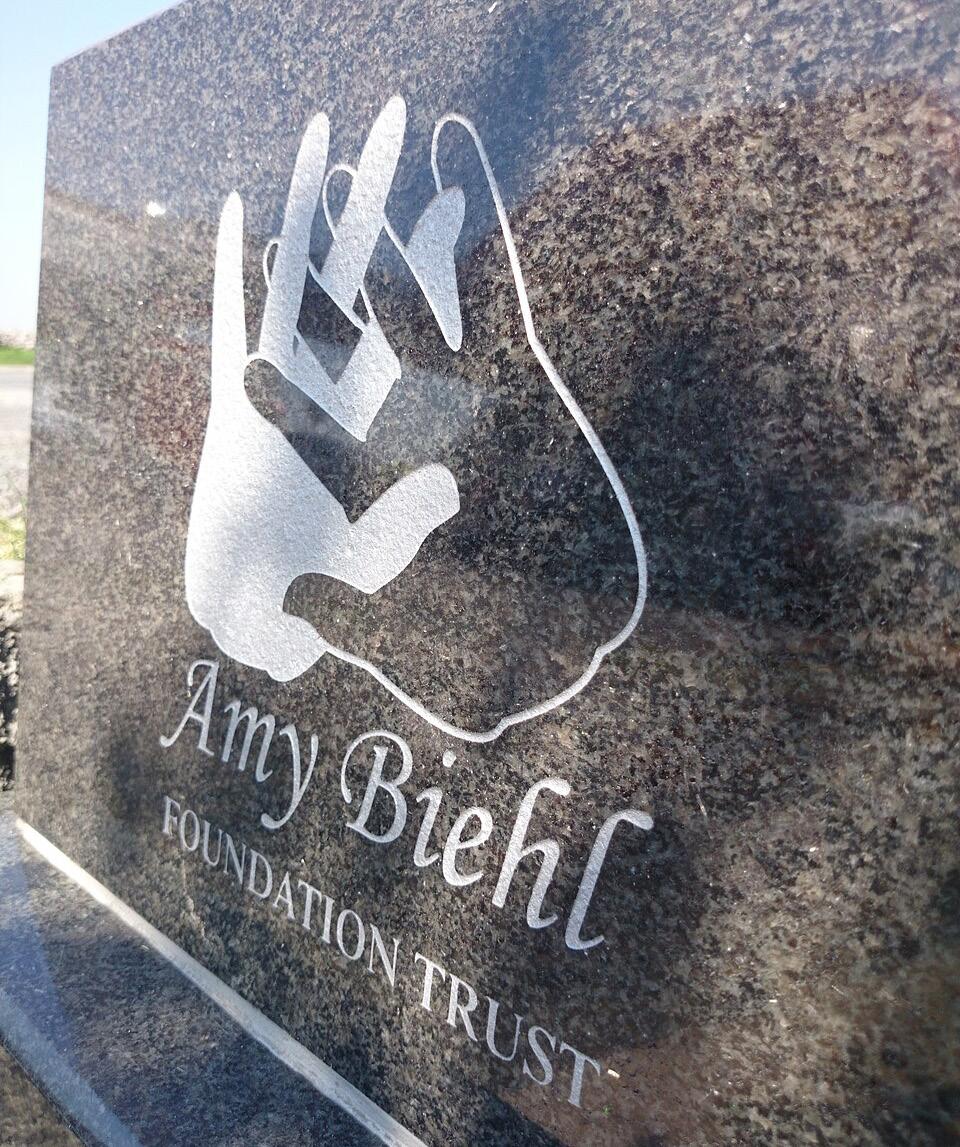

Kevin Chaplin is a renowned social entrepreneur with a proven track record of driving positive change. With over two decades of experience in banking and leadership roles, Chaplin has demonstrated his ability to think strategically, solve complex problems, and inspire others.
As the founder and MD of the Ubuntu Foundation and Amy Foundation, Chaplin has dedicated his life to empowering youth and promoting social cohesion. His passion for social justice and his commitment to making a positive impact have earned him recognition as a thought leader in the field of philanthropy and social entrepreneurship. Chaplin’s expertise extends to various areas, including leadership, strategic thinking, and social activism.
He serves on the boards of several prominent organisations, contributing his valuable insights and guidance.

Author Richard Mulholland


















Unless you have been sleeping under a rock of late, you’ll have heard the Chicken Little warnings: “The AI bubble is bursting.” It is a gripping headline, but it misleads. The bubble is not about AI disappearing. It is about overheated investment expectations cooling. Mistake that for the death of AI and you’ll risk missing a technology that is reshaping industries everywhere.
Let’s start with some clarity. A financial bubble is when people pay far more for something than it is currently worth, betting on future gains. But here’s the deal… when the tulip bubble burst in the seventeenth century, tulips did not vanish from gardens. When the dot-com bubble collapsed, the internet did not evaporate. Google, Amazon and countless others thrived. And the housing bubble bursting certainly didn’t make our homes disappear. A burst bubble corrects valuations. It does not erase the useful things that lived inside it.
Today’s AI “bursting bubble” talk misses a crucial point.
If the technology itself were truly collapsing, we would not see multiple companies in the
































same niche breaking records. Cursor, Replit and Lovable, all tools that let developers and non-developers alike build software with AI, have each sprinted to one hundred million in recurring revenue in under a year. Their growth is not driven by hype. It is driven by people discovering that AI can turn ideas into working software faster and easier than ever. That is what a technology finding its fit looks like, not what a bursting bubble looks like.
Here’s the best bit. A bursting bubble is actually healthy. When valuations deflate, the noise dies down, the hype merchants disappear, and what remains are solid tools offered at fair prices. This is how technologies mature. Investors become more discerning, companies price their products sustainably, and suddenly the market becomes less of a gold rush and more of a functioning ecosystem. That is good news for businesses, creators and everyday users.
And here is the bigger picture: the future itself can be a threat if you stand still. Technologies like AI will not wait politely for everyone to be ready. When the dust settles, the winners will be the ones who stayed curious, tested, and learned while others
dismissed the moment as hype.
So, when you see sensational headlines about a bursting bubble, do not take that as a cue to step back. Take it as an invitation to lean in. This is the phase where great products become accessible, prices stabilise, and real innovation thrives outside the hype cycle. The bursting bubble is not a funeral for AI. It is the moment the technology grows up.

Richard has spoken in over 40 countries on six continents! He works with executives and speakers worldwide through his company, Missing Link, which he started at 22! Missing Link provides special presentations that ultimately attract audiences and generates income.
In 2024 he founded Too Many Robots, a fractional AI agency on a mission to help companies embed these tools of the future. If that wasn’t impressive enough, he has also written three books, Legacide, Boredom Slayer, and Here Be Dragons. Furthermore, he was voted top 40 under 40 and the top 300 South Africans to take to lunch.
Lastly, but most importantly, Richard firmly believes that you need to be yourself to be great at human-tohuman communication!

www.richmulholland.com


You have been lied to about the AI bubble. The noise is fading, but the tools that solve real problems will remain and improve. The risk is not that AI will disappear. The risk is that you will stop paying attention just as the technology becomes affordable, reliable and ready to transform the way you work. Don’t be that person.
Threaten the future.















































Author Kalnisha Singh
Director - KD Strategies


Beyond the acronym – building systems that earn trust and move the bottom line.
In a market that shouts sustainability, transformation, scorecards and an alphabet soup of acronyms - ESG, CSR, SDGs, TCFD/ CSRD, ISSB/GRI/SASB, SBTi, CDP, GHG, JET, B-BBEE, ESD/SED, SLP, IFC PS (and so many more) - it’s easy to mistake performance theatre for progress.
Stewardship is the quiet intent beneath the noise, the steady centre, the core that enables progress, forward momentum and positive impact – it is the calm operating choice: the disciplined design of how a business creates value without eroding the world it relies on.
And it often lives in unglamorous placeshow waste is handled, who gets paid on time, how employees are cared for, which
suppliers are grown locally, how grievances are heard and resolved, whether a safety near-miss becomes learning or paperwork.
Done well, stewardship lowers risk, earns legitimacy, and makes strategy executable.
Done strategically, stewardship influences operating models, turns compliance costs into quantifiable business assets, and adds to the bottom line.
In South Africa, effective stewardship naturally delivers real transformation under B-BBEE - because it hardwires fair, on-time payment; supplier development; inclusive hiring and advancement; skills pipelines; and outcome-tracked community investment. The scorecard improves as a by-product of sound operating design, not a box-ticking race. At the same time, enterprise value grows through embedded IP, stronger systems, and tangible assets built along the way - while employee satisfaction rises, productivity sharpens, supply-chain gaps close, and supplier performance improves.
Globally, the same craft speaks the language of ESG and/or IFC PS alignment: evidence-ready environmental data, labour and safety practices that withstand scrutiny, and governance cadences investors can trust.
Many contexts, one discipline.
Quietly.
In this context, digital can’t be the headline act, but it must be the spine- a small, sturdy set of evidence, roles, and rhythms that help principles become reliable action.
Well-meaning tech businesses are selling

very impressive tools and platforms to support stewardship. Unfortunately, tools before strategy often turn technology into ornaments.
Without a simple operating thesis, what decisions matter, which three metrics move them, who owns each metric, what the cadence is, and what counts as evidencethe tool becomes a dashboard in search of a business (rather than a tool supporting the business).
WE OFTEN SEE THAT THE FAILURE ISN’T INTENT; IT’S SEQUENCE.
Flip the order. Define the work, then buy the tool that serves it.
This isn’t an argument against ambition or innovation. Use AI to help you see patterns earlier, carbon intensity drifting, grievances clustering, trucks idling. Automate collection when signals are stable- meters, invoices, timestamps. But keep human judgment where the stakes are social. Let technology speed diligence, not replace care.
If (after all of that) you’re wondering how to start… the only advice is to start small and close to reality.
KEEP THIS RULE OF THUMB: PROOF OVER POSTURE.
Build a small system you can stand on - quiet digital, clear ownership, regular review.
Choose the few touchpoints where your business meets real lives and resources, payments, safety, hiring, water, waste, listening - whatever is meaningful to you.
Decide what “good” looks like for each touchpoint. Name who holds it. Decide how you’ll measure it. Collect your evidence. Review progress (monthly at first and quarterly when established). And let the results speak louder than the slogans.
THAT RHYTHM WILL FEEL ALMOST BORING.
Good.
Boring is what resilience feels like from the inside.


Kalnisha Singh is a development economist and strategic transformation specialist who designs practical, human-centred solutions across policy, operations and community impact. She turns compliance into advantage –aligning local and global requirements, while steering organisations towards sustainable outcomes.
Kalnisha leads an ecosystem of brands: KD Strategies (advisory & implementation), Our Common Future (thought leadership), Siyavela (community and impact programmes), and Women Energy Connect (capacity building for women in energy). She helps boards and operators build stewardship systems that clarify metrics, create accountable cadences and de-risk execution. Clients choose her for integrated strategy-to-execution, rigorous governance, and authentic stakeholder engagement.
Known for decisive delivery, her work is Africa-aware, community-grounded and commercially rigorous – strengthening reputation and unlocking long-term value sustainably.
linkedin.com/in/kalnisha-singh/
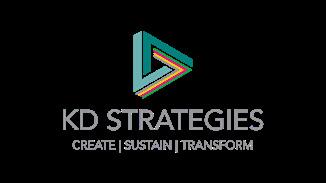

From compact 4-seat meeting rooms (from R180/ hour) to a fully equipped 90-person venue, Roamwork has the right space for every occasion. Book by the hour, half-day, or full-day.
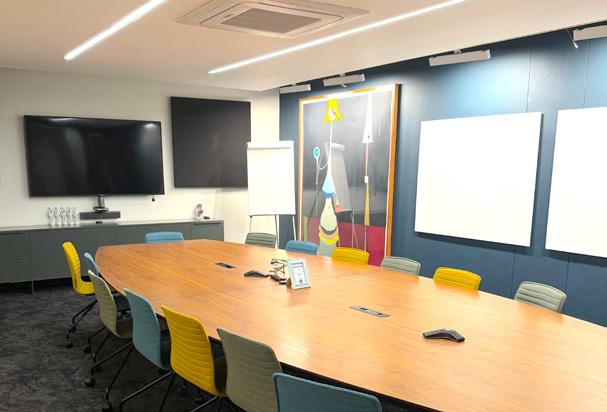
Enjoy seamless AV, LCD screens, whiteboards, printing, high-speed Wi-Fi, and private power backup so your sessions run uninterrupted—even during load-shedding.

Host and connect in an inspiring space featuring original contemporary art, a private café-style lounge, and creative energy throughout.
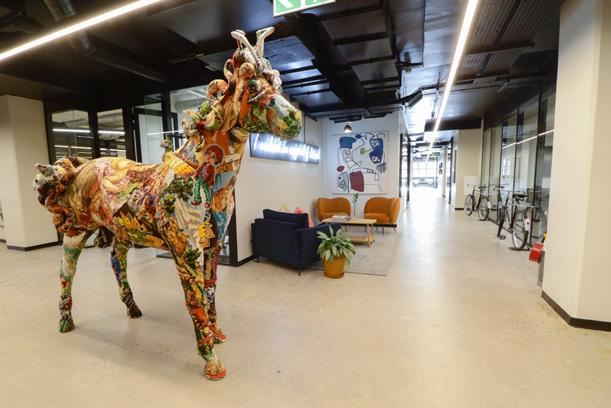
Meeting Room Rates
Executive Room (18 pax): From R800/hour | 8-seat Room: From R450/hour | 4-seat Room: From R180/hour
All rooms include LCD screens, air-conditioning, whiteboards, and access to barista-made refreshments.
Event Venue Rates (up to 90 pax)
From R1,500/hour | R5,400 half-day / R9,600 full-day

Author Liezel van der Westhuizen
Owner - Business & Mental Fitness Coach



We’re living through one of the biggest rewrites where transformation is no longer our main focus. Translation is now the centre of attraction!
How do we, as entrepreneurs and leaders, decode the flood of automation, information, and algorithm-driven tools flooding our senses and still manage to make decisions that move the needle?
At the heart of reconciling humans with the digital age sits Artificial Intelligence.
AI promises exponential productivity, optimised tasks, and fewer human errors - and we’ve seen these gains firsthand at Giraffe Brand Academy.
But here’s the paradox few acknowledge: The faster technology moves, the more carefully paced your mind needs to become.
When I coach clients around AI, I emphasise: It’s not just about tools. Mindset matters!
Because if you can’t lead yourself through the complexity of human experience, no AI tool will supplement your needs!
THE HIDDEN COST OF DIGITAL ACCELERATION
What’s really happening in the workplace?
A 2024 Deloitte study found that 59% of professionals who use generative AI daily report increased decision fatigue. Why? Because while AI reduces workload, it increases inputs - and with them, the pressure to always be “on.” Think about Netflix: you are motivated to watch more to train the algorithm. You scroll, select “like”, and log your preferences before the platform finally works for you.
Meanwhile, Microsoft’s Work Trend Index 2024 found:
• 68% of employees lack uninterrupted focus time.
• 62% spend more time reacting rather than thinking strategically.
• And 60% of leaders say their teams feel overwhelmed by the pace of change.
In short, we’re not short on information. We’re short on mental clarity.
The real leadership gap isn’t data access - it’s the ability to pause, filter, and choose what truly matters.
AI IS A TOOL. SELF-COMMAND IS A SUPERPOWER .
The dominant AI narrative? It’ll save us time…Think faster than we can.
But that assumes we’re equipped to handle the acceleration.
Here’s the reality:
• AI won’t fix burnout.
• It won’t erase the feeling of being overwhelmed.
• It won’t quiet the voice saying, “You’re falling behind”.
There was a time I didn’t tactically pace myself mentally or technically. In my eagerness to learn, AI became another engine of chaos - fuelling anxiety, comparison, and over-optimisation.
WHAT’S THE ANTIDOTE?
Self-command - running your inner world like Beyoncé runs a stage: total presence, zero panic.
Mental fitness is the emerging advantage in business.
It’s the ability to:
• Intercept self-sabotaging thoughts
• Regulate emotions under pressure
• Stay grounded in a world profiting from distraction
Mental fitness strengthens your brain’s capacity for empathy, innovation, and wise decision-making – helping you respond and not just react.
When I work with executives and sales teams, I see a clear pattern:
You don’t need to code it - you need to own it. Rihanna didn’t invent beauty. She reinvented how it works.
The leaders who thrive today know how to:
• Slow down their thinking while speeding up execution
• Use AI with discernment, not dependency
• Filter signal from noise
• Protect deep focus in a shallow world
This isn’t soft skills training. It’s mental operating system training.
The most advanced Operating System you’ll ever run isn’t ChatGPT - It’s your mind.
In this age of relentless innovation, calm isn’t complacency - it’s strategy.
Clarity isn’t just a personal win - it’s a performance multiplier.
If the old rules rewarded hustle and speed, the new rules reward:
• Emotional resilience
• Self-awareness
• Intentional action
• The strength to ignore “shiny distractions”.
The future belongs to those who use AI - without letting it use them!
So, if you want your business to thrive in 2025 and beyond, don’t just teach your team to promote an AI model. Teach them to command their minds.
Digital fluency helps you adapt.
But mental fitness? That’s what helps you lead.


Liezel van der Westhuizen is a certified high-performance and mental fitness coach, keynote speaker, and media personality. Known as The Giraffe, she helps female leaders, executives, and sales teams build unshakable confidence, resilience, and mental agility. Drawing on her background in broadcasting, her experience as an endurance athlete, and the Positive Intelligence® framework, Liezel empowers clients to stand tall and thrive in business and life.
Learn more at
liezel.co.za

Welcome to BNI Edge - one of Cape Town’s most dynamic business networking chapters, where entrepreneurs, professionals, and business owners meet weekly to share referrals, build trust, and grow together.
At BNI Edge, we believe “Who you know shapes where you grow.”
Our members represent a diverse range of industries, all committed to supporting each other through quality referrals and long-term collaboration.
Whether you’re a seasoned business owner or just starting out, visiting our chapter gives you a firsthand look at the power of structured, relationship-driven networking that really works.

Scan the QR code to apply and become part of a network where “givers gain.”

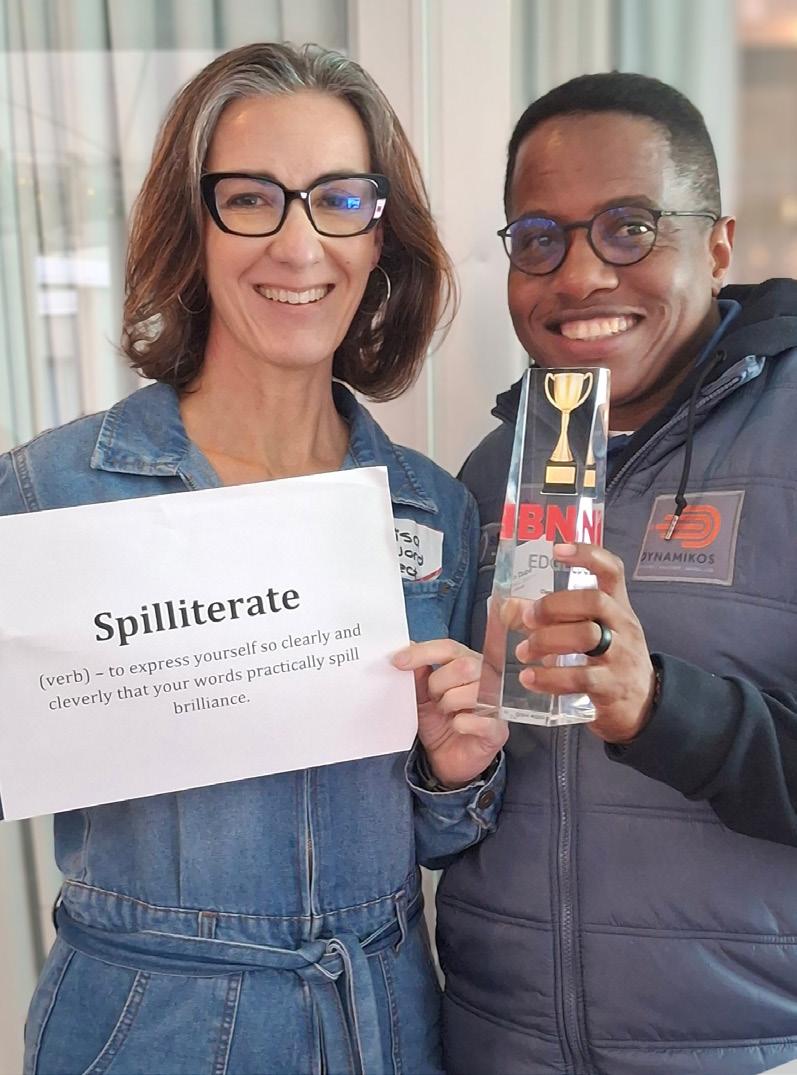
Experience the energy of a BNI Edge meeting and see why so many professionals trust the network that delivers measurable business growth.
Author Lisa Bell
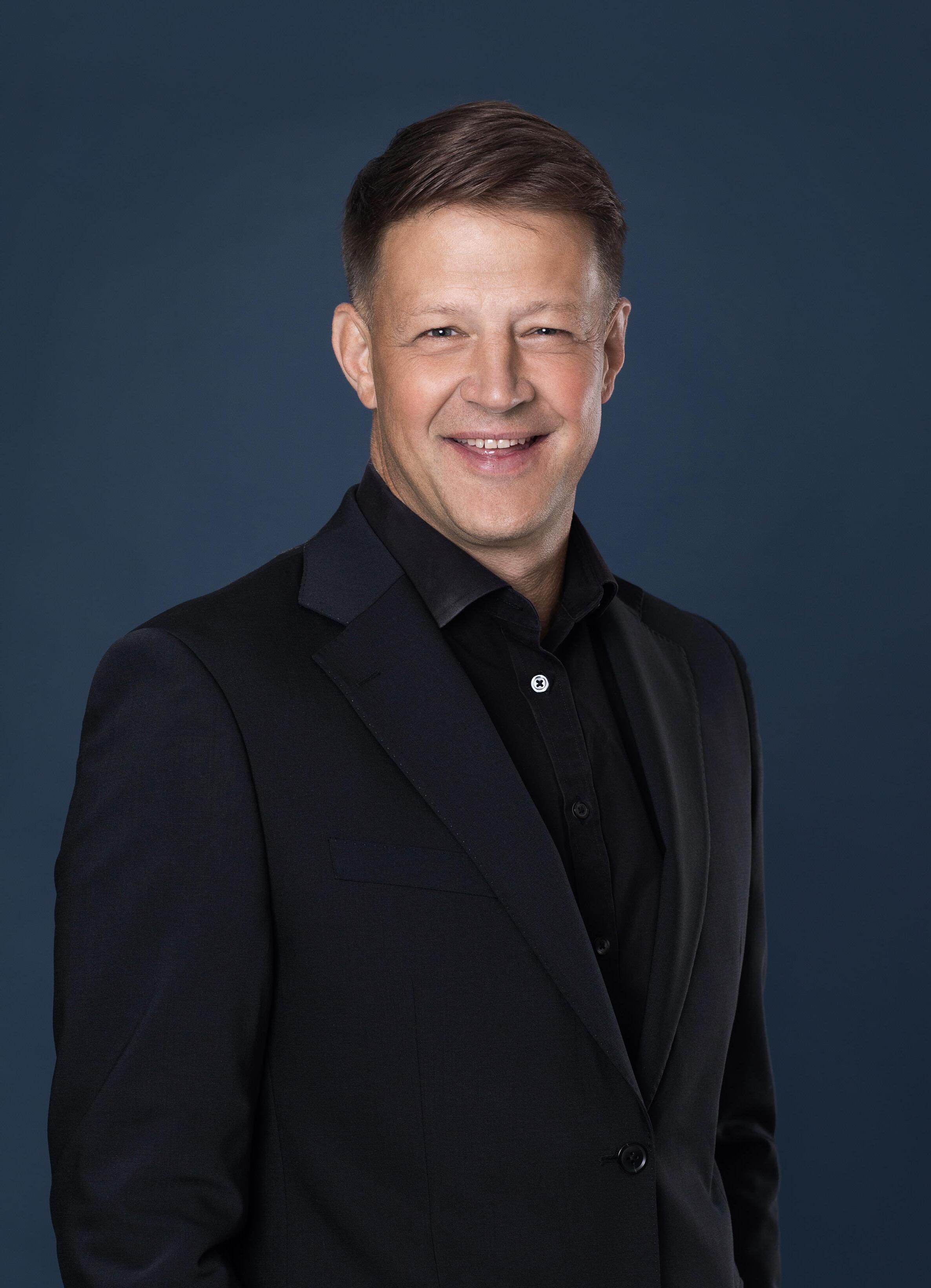

By Lisa Bell, Chief Editor of WORD Magazine
Lisa: You captained the Springboks and lifted the Rugby World Cup in 2007. What lessons from your rugby career have proven most valuable in your business ventures?
Bob: The key point is lessons I’m learning, rather than lessons I’ve learned, because it’s a journey all the way through.
I started playing rugby during a huge transition for the sport. Back then, players had day jobs - lawyers, doctors, accountants - and rugby was a passion, not a profession. When television and broadcast money came in, it became clear that players needed contracts. I was one of the youngest ever contracted Springboks after captaining the South Africa U21 side. Even at my peak, I always kept another job - working in an ad agency, taking time in the UK to play amateur rugby - because I believed in balance. The game teaches camaraderie, discipline, resilience, and self-reliancevalues you want your kids to see. Fight hard, but be the first to lift someone when they fall. Those lessons translate directly into business and life.
Lisa: Looking back, what’s the one match or moment that still gives you goosebumps and why?
Bob: Any match you win that you weren’t expected to win stands out. One that still gives me chills is the 1998 Tri Nations final against the All Blacks. We came from a record deficit and won in the last seconds. The Durban crowd was 99% South African, and the atmosphere was electric, you could cut it with a knife. Even winning World Cups didn’t match that feeling.
Lisa: Many professional athletes struggle with life after sport. How did you navigate that shift into the business world?
Bob: I’m still navigating it. It’s not easy. You question yourself all the time. Sport teaches resilience - you lose, recover, win againand I try to bring that mindset into business. I don’t view work as a series of wins; it’s about getting better, repeating what works, and cutting what doesn’t. My advice to

players is to start early. Rugby isn’t a retirement game - by 35, you need another path. Study, intern, find mentors. I wasn’t clever enough to study medicine like some teammates, but I went into advertising, learned marketing and business development, and used those skills across my career.
Lisa: You’re involved with KNF Ventures, Elixirr, and co-owning ASBH Béziers Hérault in France. Which excites you most right now?
Bob: KNF Ventures was born out of my time at Knife Capital - a government-backed Section 12J venture fund supporting innovation in South Africa. I’ve since moved to London, joining Elixirr, a high-growth challenger consultancy, where I’m a partner. We’ve expanded globally, recently opening a data and analytics academy in South Africa, feeding graduates from UCT and Stellenbosch into client projects. I also co-own ASBH Béziers Hérault, a professional French rugby club. It’s like a real-life ‘Welcome to Wrexham’ - we’re one league below the Top 14, and the goal is to bring the club back to former glory. It’s a passion project that keeps me close to the game I love.
Follow Bob Skinstad on social media:
Lisa: Fast-forward five years - where do you see yourself personally and professionally?
Bob: Consistency is key. I’m based in the UK but travel often to South Africa. My four kids are growing fast - two sons and two daughters - and we hope to settle around Cape Town eventually. If Elixirr keeps its trajectory, it’s a rocket ship I want to stay on. At Béziers, if we can climb a league, that would be another great win.
Lisa: For young South Africans in sport or business, what’s your best advice for building a career that’s impactful and sustainable?
Bob: Work hard, stay disciplined, and get along with people - those traits will serve you anywhere. Embrace technology; AI is changing everything. Young South Africans are already developing world-class solutions from home. The world is finally noticing, so take your chance and be bold.
Lisa: If you could host your dream dinner table - three guests, living or dead - who would they be and why?
Bob: Nelson Mandela - for his calm presence and humanity. Roelof Botha - a brilliant South African mind, now Managing Partner of Sequoia Capital. And my dad, who passed away - he was a doctor, a community man, and a huge rugby fan. I think he’d have loved that dinner conversation.
Lisa: Finally, what book, author, podcast, or influencer would you recommend to our readers?
Bob: A book called ‘Belonging’ by Owen Eastwood. It’s a beautiful exploration of human motivation - why teams thrive when they feel like family. He’s worked with the England football squad, the South African cricket team, and the All Blacks. It’s about creating cultures where people truly belong. (Refer to our save to faves segment)




Author Marike Herselman
Owner - MH Photography

What do we perceive as beautiful? How much of our perception is nature and how much is nurture? Where does the primitive brain kick in, and where does culture take over? As I find all my subjects beautiful because of their interactions, I decided to explore what the brain does before it can connect features to personality.
A TED Talk by Anjan Chatterjee sparked an urge to explore the concept of beauty. He is a professor of neurology at the University of Pennsylvania School of Medicine and has conducted several studies on how the brain responds to beauty. Beauty has been a major topic for decades, but has mostly been discussed through logic or speculation.
These days, we have more information thanks to neurology and the rules of evolutionary science. Beauty is subjective and influenced by factors that best support the survival of the group. Through his studies, Anjan has pinpointed certain parameters of beauty:
Composite or average faces are often found to be more attractive than individual faces. This is where the various features of different individuals are combined to create one face. It agrees with the idea that mixed races are found more attractive than inbred families. The reasoning behind this is that genetic diversity and adaptability indicate a stronger breed.
Most people find symmetrical features more attractive, as we tend to choose perfection. Think of selecting a piece of fruit in the supermarket. You tend to go for the perfectly shaped apple because of survival instincts. Developmental abnormalities are associated with asymmetries, and these imperfections in animals, plants, and humans are usually linked to parasitic infections. So symmetry is an indication of health.
Oestrogen and testosterone influence what we find attractive. Men are attracted to women whose features are both youthful and mature. If the face looks too young, she’s not fertile, and when the face is too old, reproductive success is in question. Men will look for big eyes, full lips and narrow chins, all of which show youth as well as high cheekbones, which indicate maturity. Testosterone produces typical masculine features, such as thicker brows, thinner cheeks, and a square jaw.
So what happens in the brain when we see beautiful people? Areas of our visual cortex recognise faces and activate an area that processes objects. Reward and pleasure
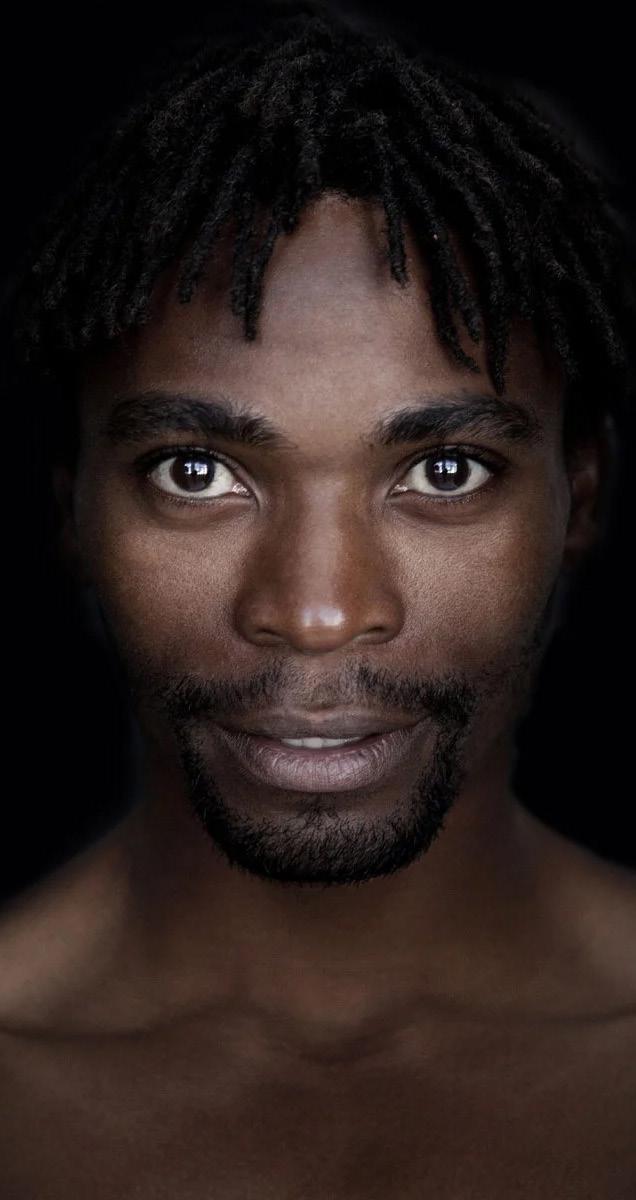
areas in the frontal cortex, deep within the brain, get activated. So in essence, the visual brain that recognises faces combines with our pleasure centres to underpin the experience of beauty. They have also found that our brain reacts to beautiful faces without thinking about beauty, but about identity, meaning that the brain automatically responds to beauty by linking a visual stimulus to pleasure.
The brain has identified beauty, but automatically takes it a step further. We also have a ‘beauty is good’ idea embedded in the frontal cortex, which overlaps neural responses with beauty and goodness, even when you’re not thinking of either. The brain seems to naturally associate beauty with
good, which could explain the biological trigger to the social effects of beauty. Attractive people receive privileges, are regarded as more intelligent, and have better jobs with higher pay. In his studies, he has found that people with minor facial abnormalities are perceived as less smart, less hardworking, less good, less kind, and less competent. So it seems the brain forms a negative association with disfigurement.

So why do I like redheads - a concept my friends can’t seem to comprehend? Why is beauty so objective? Even though the brain has such a strong influence on subconscious ideas and decisions, the primitive brain is continually challenged by popular beliefs, society, and culture. What impact has society had on our concept of beauty, and how has it changed over the past couple of years? Look at gaps in the teeth that became so popular with models when previously everyone needed braces to close those unwanted gaps. Trends seem to move away from the average, and we become attracted to what is different. Is that conscious thinking, marketing and the need to be different? Is the brain still just interested in the big eyes and full lips?
And then culture and conditioning. What we are used to will be attractive to us, while previous experiences might create a negative association with a feature that might otherwise be regarded as beautiful. Be it conscious or subconscious, our perception of beauty is continually evolving as we change and develop as a species. Next time your head turns or you do a ‘double take’, take some time to figure out what triggered it. Popular belief? What you’re used to, or your brain is trying to get your genes into the next generation.

I am a professional portrait photographer who believes in the philosophy that “it is more important to click with people than to click the shutter.” - Alfred Eisenstaedt
My approach is quite personal. I believe in the honest connection between photographer and subject, aiming to capture the sincerity and beauty of that particular moment. My passion for human psychology and the true expressions that await motivate me every day, which is why I genuinely love what I do. My aim is to help business owners, entrepreneurs, corporates, SMEs, and non-profit organisations communicate a higher level of professionalism, which subsequently builds long-lasting, trusted relationships between you and your intended target audience. In my work, I strive to build trust with my subjects, creating an environment where they feel comfortable enough to reveal their true selves. Through this connection, I can showcase their inherent beauty, uniqueness, and charm. Let’s embark on a journey of capturing your true essence together.


A decade of crafting brands, shaping stories, and saying it better.
From scribbled ideas to scroll-stopping brands, The Word Architect has spent the last decade crafting content and creative that connects. We’ve published books, launched magazines, designed brands, and helped businesses find their voice.
Now, we’re celebrating a journey of growth, grit, and great design, and looking ahead to even bolder chapters.
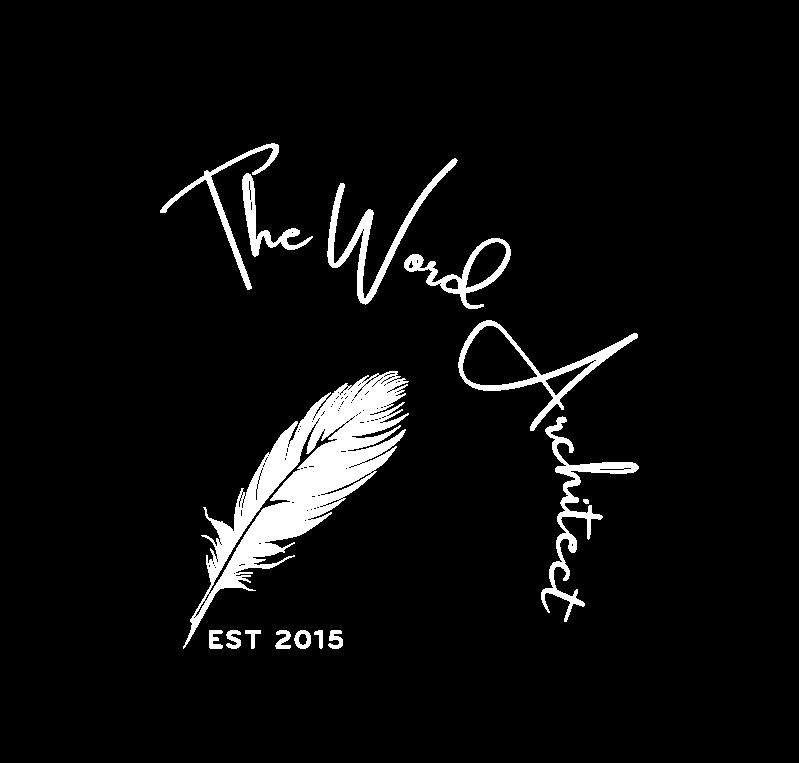
Want to build something unforgettable with us?
Let’s talk words, strategy, and standout storytelling.
thewordarchitect.co.za


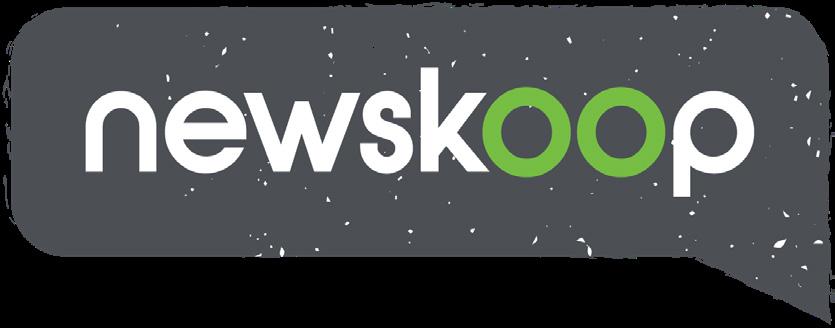

For much of the 20th century, community radio newsrooms operated from a handful of central locations, where dedicated teams gathered around bulky equipment to source, verify, and broadcast news. In the 1990s, breaking news often arrived via telex or telephone lines, and reporters relied heavily on local contacts. Editorial decisions typically flowed top-down, and available channels and slow communication methods limited the scope of content.
Today, Newskoop revolutionises this model as a content producer for community radio stations, operating in a digital world where news can be sourced from every corner of the globe instantly. This digital transformation enables Newskoop to supply verified, timely, and relevant news stories to community stations, empowering them to keep local audiences informed with breaking and trustworthy news.
Author - Nadine Watkins
SOURCING NEWS IN A DIGITAL ERA
Newskoop harnesses an extensive range of digital sources to gather news. Beyond traditional wire services, it scans social media feeds, local news websites, digital newsrooms, podcasts, and live streaming channels. The ubiquity of smartphones and immediate access to information mean eyewitness reports and breaking events can surface online faster than ever.
However, this explosion of content creates challenges around misinformation and fake news. Newskoop’s team uses a combination of advanced digital tools and journalistic expertise to verify information rigorously. Cross-checking multiple sources and analysing metadata are daily tasks that ensure news supplied to community radio stations is authentic and factual.
SELECTING CONTENT FOR COMMUNITY RELEVANCE
With such a wealth of information at its
fingertips, Newskoop expertly curates news stories that are most relevant to community radio audiences. The editorial team evaluates which topics resonate locally while maintaining awareness of important national and international news that affects communities.
Newskoop’s approach balances immediacy with context, providing listeners with clarity and background to understand the significance of each story. Through ongoing consultation with partner community stations and data analytics, Newskoop ensures that the news reflects the interests and needs of diverse audiences. A vital part of the selection process is combating misinformation. Newskoop maintains a tough fact-checking protocol that screens for credibility, consistency, and potential bias. This vigilance helps protect community radio stations from the pitfalls of amplifying false or misleading reports, reinforcing their role as trusted sources.
Once news is sourced and selected, Newskoop takes pride in creating audio content designed specifically for community radio’s unique format. The production team transforms verified information into clear, engaging news bulletins, combining crisp narration with relevant sound bites and expert insights. Radio demands an immediate, accessible, and conversational style that connects with listeners. Newskoop avoids jargon while preserving journalistic integrity, delivering bulletins that are easy to follow but rich in substance. Production is agile, with updates delivered multiple times daily to capture developing stories.
The surge of digital news has amplified the challenge of misinformation, making media literacy more essential than ever. Newskoop supports community radio stations by providing tools and training to detect and reject fake news. Journalists and presenters

learn fact-checking skills and ethical reporting principles to uphold news quality. Listeners also benefit from educational segments produced by Newskoop that boost their ability to critically evaluate the flood of information online. This strengthens community trust and encourages informed citizenship in an era where misinformation can spread rapidly.
The evolution from analogue newsrooms to a fully digital content production hub illustrates Newskoop’s commitment to innovation and quality journalism for community radio. By embracing all digital news sources while rigorously verifying and curating content, Newskoop bridges global news with local voices.
This digital digging ensures community radio stations remain vital hubs of trustworthy information, helping listeners navigate today’s complex media environment with confidence. As digital landscapes continue to shift, Newskoop’s role as a reliable content producer and news decoder underpins the enduring strength of community radio in South Africa and beyond.
GET IN TOUCH TO AIR YOUR BRAND TODAY!
oursaladmix.com


Author Kim du Plessis
Managing Director - Our Salad Mix

Business, as we knew it, has changed, not because someone rewrote the rules with pen and paper, but because the game now plays out in pixels, algorithms, and the swirling habits of online consumers. Gone are the days when strategy meant managing distribution networks, print ads, and word-of-mouth buzz alone. Today’s business leaders need to understand a fast-moving digital world to stay ahead.
DIGITAL IS NO LONGER JUST A SIDE HUSTLE
For too long, digital was treated like an add-on, something handled by a separate team managing websites or running social media ads, while the “real” business carried on elsewhere. Those days are over. Digital isn’t an extra anymore; it’s the heart of everything. Whether it’s clicking “buy” on an online store or analysing data with AI,

digital threads weave through every industry now. Ignore it, and you might as well disappear.
The digital landscape is a vast buffet. There’s social media, email newsletters, SEO, influencer marketing, videos, podcasts... the list feels endless. It’s tempting to throw everything at the wall and hope something sticks. But spreading yourself too thin rarely does the trick. The smarter move? Pick one or two channels, master them, and build from there. Doing one thing well creates momentum and real results.
This might sound quirky, but think of digital strategy as making a salad that’s
fresh and satisfying. First, you need the basics: lettuce, tomato, and cucumber. For business, that means a clear core message: your “who,” “why,” and “how.” Without this, everything else is just fluff.
Next, you need your bowl, the infrastructure that holds it all together: your website, your channels, your content engine that gets your message out there.
Finally, the dressing and the flavour are your growth tactics. This includes amplifying what works, boosting campaigns, and scaling up. The order matters. Pouring on dressing without the basics won’t fill anyone up.
Remember when customers followed a neat path: they heard about you, thought it over, then bought? Those days have vanished. Now, customers zigzag across platforms, discovering you on Instagram, checking reviews on Google, asking friends in WhatsApp groups and comparing prices online before finally deciding.
Winning businesses meet customers at every turn, showing up consistently and honestly across digital touchpoints. It’s not about one big ad anymore; it’s about building trust through a steady presence.
Anyone can jump into digital, but staying visible takes grit. Sporadic posts and random campaigns won’t build loyalty or trust. Success comes from rhythm, showing up week after week with messages that echo your core story. It takes effort and resources, but without a consistent presence, digital quickly fades into the background.
In the past, bigger meant better; big companies had the edge with their resources and brand clout.
Digital has flattened that playing field. A nimble start-up can outsmart large corporations by moving faster, adapting more quickly, and responding in real time to what customers want. In this game, speed and flexibility beat size.
Digital communities chat. The brands that thrive today are those creating spaces where people connect, not just with the brand, but with each other. The new rule? Don’t just sell stuff. Build belonging.
Cracking the digital code isn’t about chasing every shiny new tool or trying to be everywhere at once. It’s about laying the groundwork, your message, your platform, your growth, step by step. Do less, but do it brilliantly. Stay steady. And above all, remember: digital isn’t just a garnish anymore; it’s the main course of your business.




Kim du Plessis is known for her entrepreneurial flair and passion for her creativity and business strategy, with over 20 years of national and international experience within her field. Kim is the Director of a media agency, Our Salad Mix, focusing on radio and media campaigns.
Kim’s understanding of client’s wants and needs and her value in hard work, loyalty, integrity and humour makes Kim the perfect person for the job!
oursaladmix.com
Author WeWork
Coworking & Office Space


The digital revolution is complete, and the rules of business have been fundamentally rewritten. For years, companies treated the office as a fixed cost; a necessary piece of physical infrastructure. Today, amidst the hybrid era, that perspective is obsolete. The office has been decoded and reassigned: it is now a dynamic, people-centric tool and a critical component of modern business strategy.
Flexible office solutions, like those provided by WeWork South Africa, are no longer a fringe option for freelancers or startups; they are the strategic scaffolding supporting the new, agile global enterprise.

The most significant shift in the new business landscape is the radical realignment of priorities from cost-cutting to talent retention. The workplace has moved from the domain of finance to the heart of HR strategy.
The greatest signal of this change is the realignment of Corporate Real Estate (CRE) teams, with nearly one-third of companies now having their real estate function report directly to Human Resources (HR).
• Flexibility is the Price of Admission: Data shows that an overwhelming majority of employees prefer a hybrid work setup. Crucially, up to 71% of hybrid workers are likely to look for new jobs if flexibility is taken away.
• Winning the Talent War with Amenities: To attract and retain this discerning workforce, the office must be a compelling experience. WeWork delivers this instantly by providing wellness-focused amenities that matter to employees. For instance,
locations like The Link in Rosebank are equipped with dedicated Wellness Rooms and Parents’ Rooms, while 155 West St in Sandton offers the social appeal of an on-site Barista and Professional & Social Events. These are high-value benefits that showcase a deep investment in employee well-being.
If digital tools handle solo work remotely, the physical office’s sole mission is to be a destination for purpose-driven engagement. We have identified the primary driver for returning to the workplace: collaboration. Global data confirms this shift, showing a significant surge in demand for collaborative space, with meeting room bookings increasing sharply worldwide.
• From “Place for Presence” to “Destination for Purpose”: WeWork spaces are intentionally designed to facilitate the full spectrum of modern work. Open Common Areas function as “living-room-style” workspaces for serendipitous meetings,
while dozens of fully-equipped Meeting Rooms accommodate the surge in team collaboration and video conferencing.
• Instant Infrastructure: Furthermore, in locations like 80 Strand Street in Cape Town, the entire infrastructure- from lightning-fast, secure High-speed Wi-Fi to “loadshedding-proof” backup power- is provided as a reliable, ready-to-use service, ensuring the digital connection required for high-stakes collaboration is never compromised.
In a world defined by volatility and rapid digital change, the ability to scale up or down quickly is paramount. This makes portfolio agility the final, defining rule of modern corporate real estate. Businesses can no longer afford to be paralysed by long-term, fixed lease commitments.
• Instant Portfolio Flexibility: WeWork’s product suite provides the operational flexibility to meet the demands of modern businesses. Solutions like Private Offices for teams of all sizes offer move-in-ready space with monthly flexibility.
• Access on Demand: For decentralised teams, WeWork All Access and WeWork On Demand provide employees with credits to book spaces by the day and meeting rooms by the hour across all locations, including 155 West St in Sandton and The Link in Rosebank. This allows companies to deploy a distributed workforce and manage their footprint in response to real-time needs, perfectly aligning the physical space strategy with the fluidity of the digital business model.
• In the age of Decoding Digital: The New Rules of Business, the flexible office is no longer an asset class; it is a business strategy enabler.
The new rules demand a workplace that is agile, resilient, people-focused, and collaborative. By partnering with WeWork, businesses implement a strategy that is simultaneously human-centric and digitally driven, ensuring their physical space serves as a competitive advantage that attracts talent and fuels growth.

wework.co.za

Author Andre du Toit
Owner - The Big Positive Guy


Let’s be honest - business has always had “rules.” Some are carved in stone (pay your taxes, respect your clients), others are unwritten (never eat the last samoosa at the board meeting). But in the digital era, those rules have not just changed, they’ve been rewritten, remixed, and re-coded faster than most of us can say “Please update your software.”
The digital world doesn’t ask for permission before disrupting us. It just shows up with new rules, new players, and new possibilities. Some resist. Others complain. But the smart ones? They lean in, adapt, and find opportunity in the chaos.
Remember when doing business meant heavy briefcases, secretaries guarding the CEO’s door, and everyone waiting for the fax machine to cough up a contract? Now? The CEO is on a Zoom call from a coffee shop, deals are signed on a tablet mid-flight, and employees can work in pyjamas from their kitchen table - as long as the Wi-Fi doesn’t collapse.
The “corner office” has been replaced by the “laptop lifestyle.” Digital has democratised the playing field. Whether you’re a startup in Stellenbosch or a corporation in New York, the rules are the same: fast beats slow, connection beats hierarchy, adaptability beats tradition.
(DON’T WORRY, IT’S SHORT)
Data is the New Gold - But Only if You Mine It Wisely
We’re drowning in data. Every click, swipe, and purchase leaves a trail. But here’s the catch: information isn’t power - interpretation is. The businesses winning today aren’t the ones with the most data, but the ones who can decode it into action.
So, ask yourself: are you using your customer insights to genuinely serve them, or just to spam them with “exclusive offers” they never asked for? Spoiler: the latter doesn’t count as a digital strategy.
AI Won’t Steal Your Job
(But Someone Using AI Might)
Artificial Intelligence is everywhere, from your Spotify playlist to the chatbot pretending it cares about your complaint. Many fear it, but here’s the thing: AI isn’t here to replace us. It’s here to replace the boring bits.
The winners of the digital age are those who learn to collaborate with machines. Use AI to crunch numbers, automate tasks, or brainstorm ideas at midnight. Then add the one thing machines can’t: your humanity — empathy, creativity, humour, and heart.
is Still the Currency
You can have the slickest app, the flashiest website, or the most viral TikTok dance. But if people don’t trust you, it’s game over. In the digital world, reputation travels at the speed of a retweet.
So be transparent, be honest, and yes, admit when you mess up. Customers forgive mistakes; they don’t forgive cover-ups.
Speed Matters, But So Does Soul
Today’s clients expect instant responses. (If your website takes longer than 3 seconds to load, half of them are already gone.) But in the race to go faster, don’t lose your soul. Automation should enhance relationships, not replace them.

There’s a reason the word “customer” still has “human” in it (okay, not literally - but you get the point).
Yes, Peter Drucker said, “culture eats strategy for breakfast.” Let’s update that: culture eats digital for breakfast, lunch, and supper.
You can invest in shiny new platforms, but if your team doesn’t feel empowered, inspired, and included, it won’t matter. People power digital. A toxic culture can’t be fixed with an app.
Of course, digital transformation isn’t all glamour.
There are still those awkward moments:
• Accidentally leaving the Zoom camera on when you stand up in shorts and a suit jacket.
• Sending a heartfelt sales pitch… to your mother-in-law instead of your client.
• Struggling to look “visionary” when your Wi-Fi freezes mid-presentation and you’re left staring like a stunned meerkat.
But here’s the thing: these moments remind us that while technology evolves at lightning speed, we remain gloriously human. And maybe that’s the point - digital gives us tools, but it’s our imperfections that make us relatable.
We stop fearing it. We start playing with it. We experiment, fail, learn, and try again. We don’t need to be experts in coding or blockchain to thrive.
What we need is:
• Curiosity (ask more “what ifs”)
• Courage (try the new tools before you’re ready)
• Compassion (remember that behind every screen is a person)
The new rules of business are less about technology itself and more about how we choose to use it.
Here’s the final truth: there’s never a perfect

moment to “go digital.” You’ll always feel too busy, too tired, too broke, too something. But waiting means falling behind.
So take the leap. Build the app. Launch the campaign. Host the webinar. Experiment with AI. Fail fast, learn faster. Because in the digital age, the only real mistake is doing nothing.
We’re not just decoding digital - we’re rewriting the rules of how we live, work, and connect. And it’s not as scary as it seems.
So log in, plug in, and more importantly: show up with your humanity intact. That’s the rule no algorithm can ever change.
• If you learn to ride the digital wave, you won’t drown in it.
• Digital may have changed the tools, but trust is still the timeless rule.
• Use tech to go faster, but never forget to go deeper.
• Technology may run the systems, but people run the show.

Andre du Toit is a professional speaker and CEO of High Impact Public Speaking.
Known as “The Big Positive Guy,” he helps leaders and teams communicate with confidence and purpose.
His mission is simple: changing lives one talk at a time.
andre@bigpositiveguy.com




From our roots in 2010 to a firm defined by Purpose, Precision, and Performance
Mianzo has spent 15 years building more than portfolios. We've built trust, transformed mandates, and helped shape the evolving investment landscape.

Author George Eadie
Executive & Expert Coach


The concept of the “low ego” leader has gained powerful traction, and for good reason. Many of us have a scar from exposure to the arrogant, power-hungry individual - the one whose short-term focus, self-serving agenda, and exploitation of others poison the well of an enterprise.
Leaders, finding themselves in a position of authority, are rightly motivated to avoid being perceived as that tyrant. But in the rush to shed the negative archetype, we’ve inadvertently stumbled into a hidden cost: we’ve thrown out the baby with the bathwater, risking the most essential resource we possess for creative leadership - our own sense of self.
Somewhere along the line, the term “ego” was divorced from its original psychological meaning - the central, reality-testing executive function of the psyche - and became synonymous with egotism or arrogance. The culture correctly recoiled from the self-serving tyrant, but in doing so, it mistakenly taught us to fear the very essence of our individual identity and unique perspective.
The truth is, effective leadership requires nothing less than our holistic intelligence and full capacity. What sets your enterprise apart, what makes it uniquely valuable, is, by necessity, a reflection of your uniqueness - the leader’s uniqueness.
In coaching, we define the ego not as arrogance, but as our fundamental resource: our sense of identity, our own significance, our preferences, and our desires. It is neither negative nor positive; it is a feature of being human and a core resource for a leader.
When we make an effort to be “low ego,” we risk losing the source of our distinct contribution. The authentic ego is, in fact, a homing device for your authentic leadership style and voice. It helps you chart a course in the storm, discern left from right, and make choices informed by the aggregate of your experience and your body’s somatic signals in the moment, aka your gut.
When a founder is caught in the trap of imposter syndrome, one of the deepest roots is often that they are simply not letting themselves do things the way they WANT to do things. They have been conditioned to doubt the benevolence of their wants. But what they quickly realise is that their deepest wants are the opposite of selfish: they want a super business that delights customers, is meaningful to their staff’s families, and is sustainably profitable for all involved, including themselves.
The common response to this doubt is to default to defensible leadership: choosing a path because it is “well-researched,” passes the peer sense-check, or is dictated by “best practice.”
The problem? Choosing an approach that doesn’t pass the gut-feel test of, ‘I want this, in this way,’ often leads to shots fired without muster. When we later wonder why the approach failed, even though the data said it should work, it only fuels the doubt
and insecurity we sought to avoid. The leader becomes detached, operating their business as an overly thought-through, external machine.
The breakthrough is to allow yourself to do things the way you want to, simply. Not because there’s a statistical reference point, but because it’s an approach you intuitively think will work. This shift from detached, defensible leadership to authentic, high-conviction leadership has an immediate, palpable impact:
1. Leader Vitality is Restored: The leader instantly feels back in the driver’s seat of their life and business, experiencing a renewed sense of vigour and vitality. They are immersed in their life again. This is for two reasons. Firstly, we generally work harder, post-decision, to make things work if we’ve staked something personal on the decision. Secondly, when we’ve made it personal, we’re that much more curious to see it unfold, raising our attention in the present moment.

2. Positive Risks Emerge as Culture: Leaders begin to take positive, spontaneous risks. This could be over-servicing a customer just because it feels like the right thing to do, or going the extra mile for a staff member in distress. These spontaneous acts of authenticity often develop into a defining, unique feature of their business.
3. Inoculation from Nihilism: As these unique choices stack over time, they build a powerful body of evidence: proof of the leader’s unique impact on the world. This self-directed impact inoculates the leader from a sense of nihilism. It is increasingly evident that they matter.
The challenge, and the reason this is a truly courageous choice, is that for much of your life, you’ve likely been encouraged to sense-check your ideas against peers or best practice. Stepping into your unique power requires you to make choices for which there is no statistical reference point or comparison - and to do so with conviction.
This is the path of authentic self-expression, and the feeling of being alone can be overwhelming.
This is why the best support you can find is a tribe - a community of people who, in their own way and context, are doing the same. To sustain your new, authentic leadership style, your tribe must share and relentlessly value one moral above all others: courage.
To be truly fulfilling, a life and a business requires an essential level of courage. When you are taking an action that is instinctive, courageous, and of high consequence, the tendency is to feel isolated. However, I encourage my clients to practise a simple visualisation:
Picture your tribe of fellow ‘couragers’ standing shoulder to shoulder with you. In this moment with you, you realise you stand
alongside all those who have come before you, and all those who will stand in the future, for themselves and for what is uniquely within their conviction. It is this shared courage that emboldens us all to write our own unique story.
Reclaim your ego. It is your ultimate competitive advantage.


GEORGE EADIE
George Eadie lives on a farm in Elgin, South Africa, having traded city life in Cape Town for privacy, adventure, and nature. Formerly a CEO in publishing and Partner in Leadership Service Consultancy, he has led through global challenges and gained diverse experience across South Africa and the Middle East. As a coach, George works with business owners and ultra-high-functioning executives. He also runs the Cape Town chapter of Civitas, a community where entrepreneurs support each other in scaling their businesses through peer learning. Personal growth is essential to George, shaped by deep psychotherapy, the loss of his brother, and participation in men’s meditation and breathwork. He is certified in flow consulting, strength finder, and integral coaching.
george-eadie.com


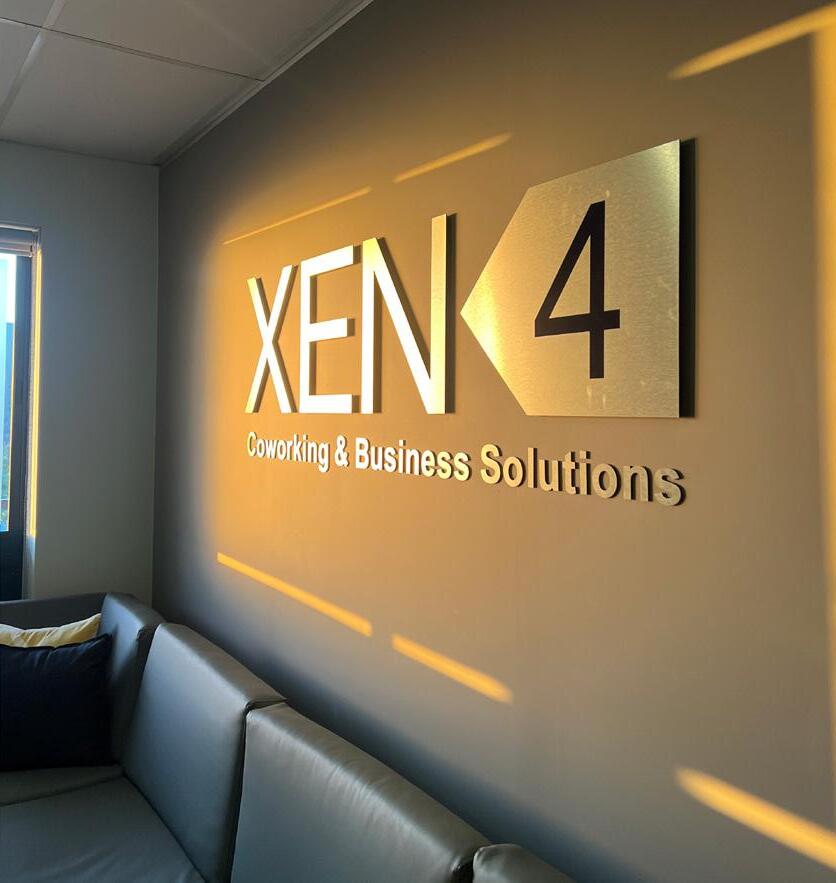
Discover a professional workspace that works for you. Whether you need a premium business address, a meeting space, or a flexible desk, XEN4 provides modern, affordable solutions designed for productivity and connection.
Enjoy high-speed uncapped Wi-Fi, constant power supply, and a vibrant environment tailored for remote professionals, entrepreneurs, and small teams.
Gain all the perks of a physical office, without the overhead.
• Prestigious business address
• Mail handling and courier parcel service
• Optional call forwarding with dedicated Cape Town number
From R330/month (excl. VAT)
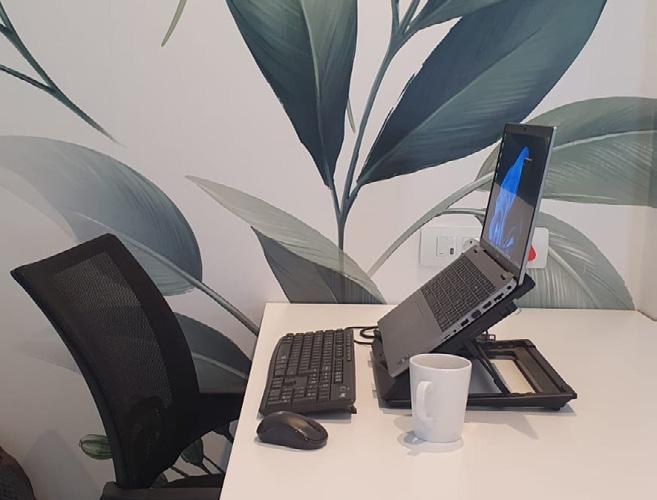
Flexible options for every work style:
• Flexi Desks from R150 half-day
• Conference Rooms (4 people) from R215/hour
• Boardroom (10–12 people) from R345/hour
(All prices exclude VAT)

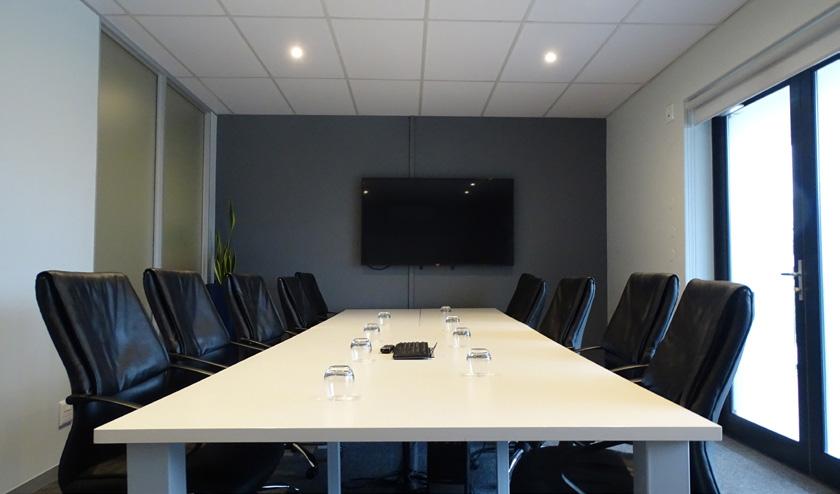
Authors Rhoda + Alfonso Stoffels
Owners - Nickay Productions
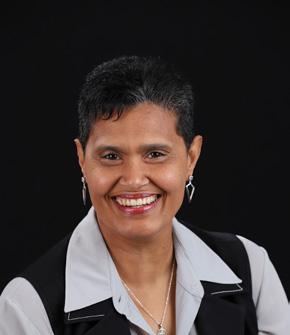

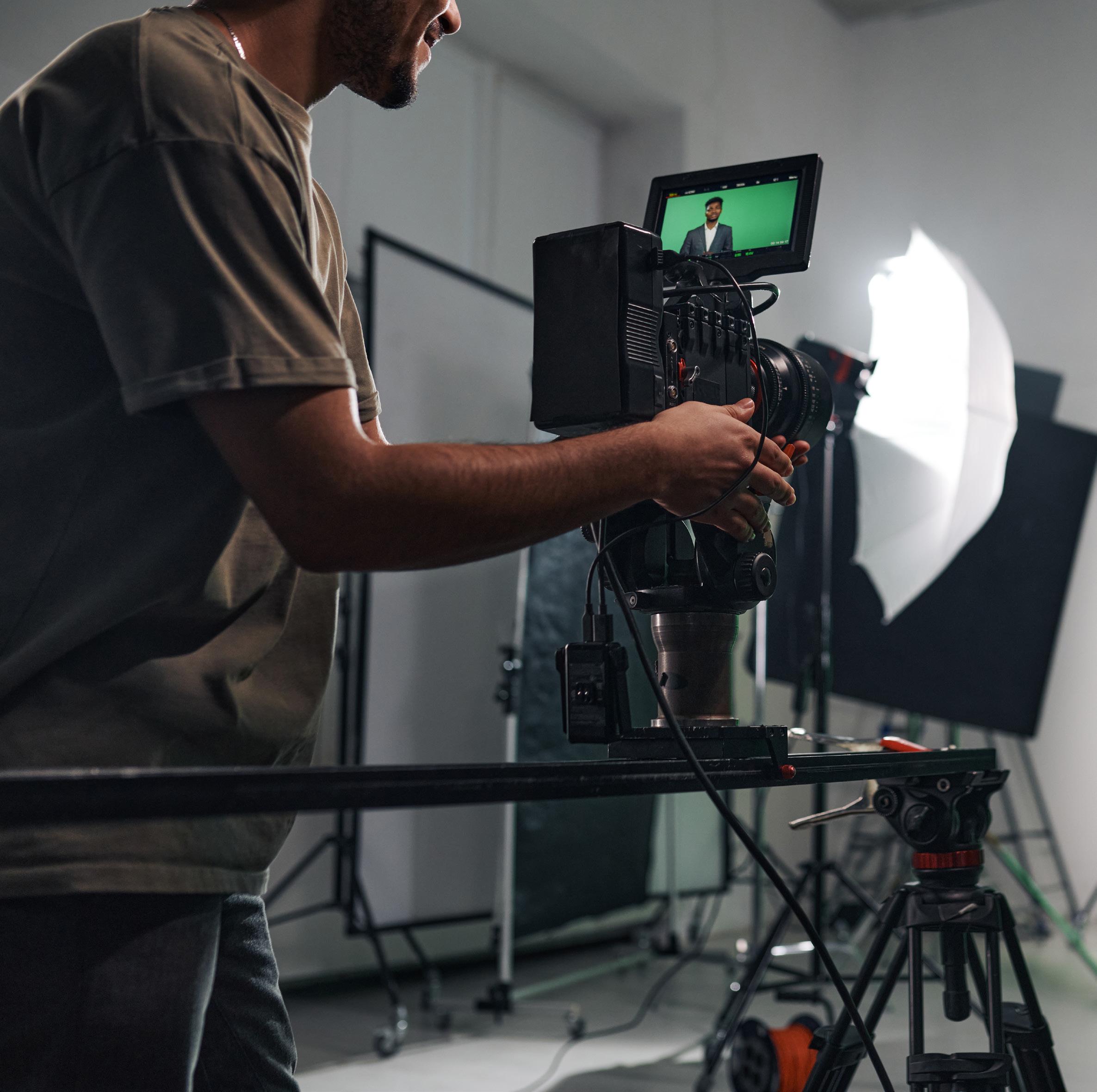

In today’s hyper-connected world, where algorithms shape attention and content travels faster than ideas, creative companies face a critical challenge: adapt or become obsolete. For those in media and content creation, the digital revolution isn’t a threat; it’s an opportunity.
Many production studios that emerged before the smartphone and social media era have had to rethink how they operate, deliver, and connect radically. Success stories in this space reflect a mindset that embraces change, innovation, and audience relevance.
At the heart of content creation lies storytelling. But in a digital-first landscape, storytelling alone isn’t enough. The winning formula now blends creativity with a deep understanding of digital strategy: platform algorithms, audience psychology, and user behaviour.
As one seasoned creative puts it, “In today’s market, creativity without strategy is just noise.” The shift is from simply producing beautiful work to ensuring it performs and resonates emotionally and digitally.
Some production teams were early adopters of cloud-based collaboration, remote workflows, and digital asset management, technologies that have since become industry norms. This future-forward thinking helped them scale efficiently, collaborate across time zones, and remain agile in changing market conditions.
During the global pandemic, for example, when traditional production models were disrupted, nimble teams quickly pivoted to virtual production, livestream services, and rapid-turnaround editing. Those who embraced digital transformation didn’t just survive; they grew stronger.
NEW RULES: BE NIMBLE. BE VISIBLE. BE HUMAN.
These three principles have become a modern creative mantra:
• Be Nimble: Adopt new tools and platforms without losing your creative identity.
• Be Visible: Optimise content for both searchability and shareability, aligning with digital behaviours.
• Be Human: Prioritise emotional connection and cultural relevance over perfection.
In an age where attention is currency and relevance is fleeting, these principles offer a compass for navigating the fast-moving digital landscape.
Don’t
Each digital platform has its own tone, tempo, and expectations. Instead of copying trends, study the digital behaviour behind them.
2. Invest in Scalable Infrastructure
From cloud editing suites to virtual production tools, digital infrastructure allows for speed, flexibility, and futureproofing.
Even with the rise of AI-generated content, nothing replaces the power of authentic storytelling and emotional resonance.
As AI, immersive media, and decentralised platforms reshape how content is produced and consumed, the creative world must continue evolving. The challenge isn’t merely technical; it’s philosophical.
Digital isn’t just a medium; it’s a mindset.
Those who thrive will be the ones who balance artistry with adaptability, those who not only decode the digital shift but help shape what comes next.


Rhoda and Alfonso Stoffels are the creative forces behind Nickay Productions, a Cape Town-based multimedia company making waves in the industry. Their shared passion for storytelling and their keen understanding of the digital landscape have propelled them to success. With a focus on online streaming, social media management, and educational content, Nickay Productions has become a go-to for brands seeking to connect with audiences in a meaningful and engaging way. Rhoda and Alfonso’s ability to blend creativity with strategic thinking has positioned their company as a leader in the competitive world of multimedia.




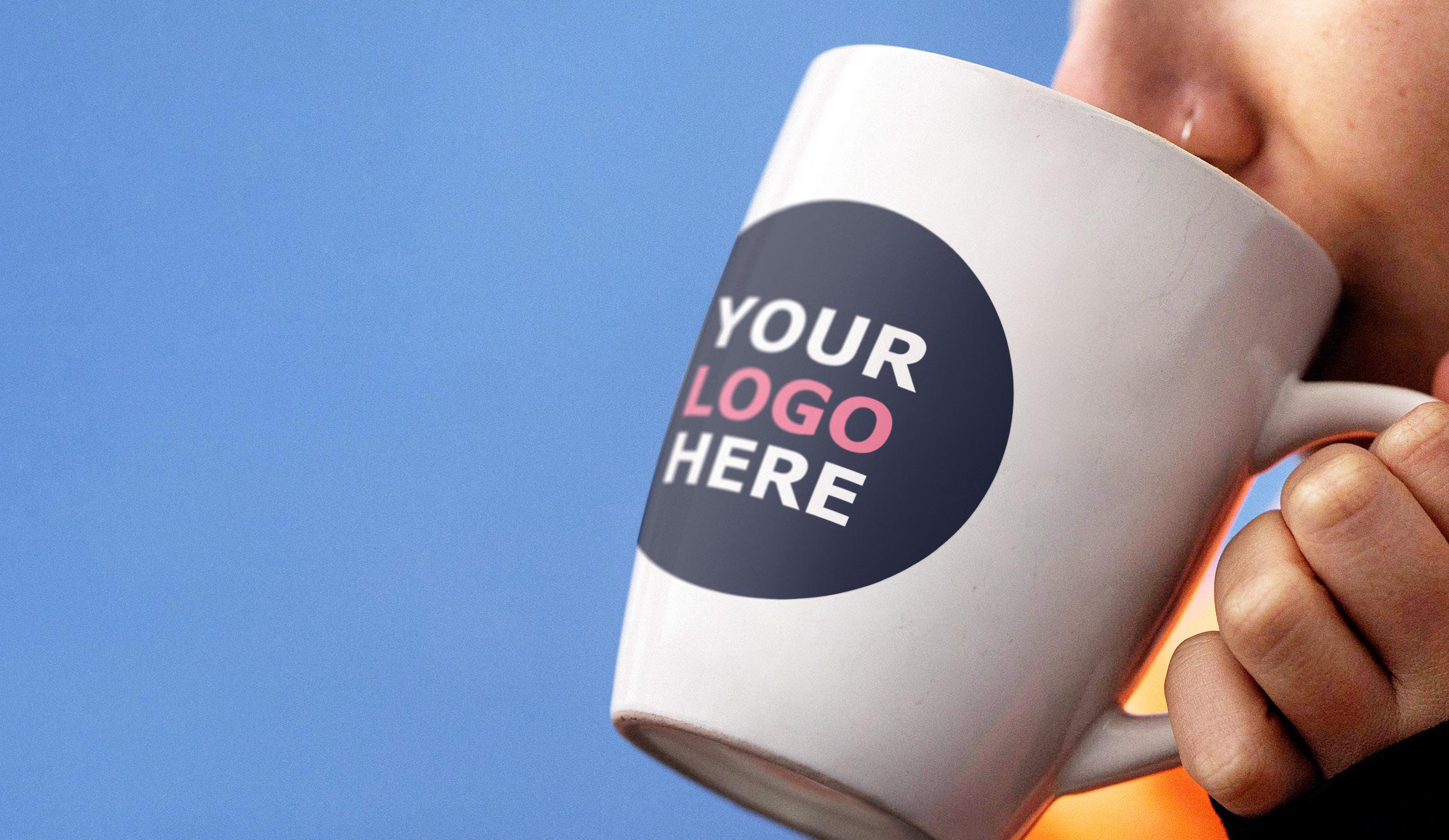

Bespoke Corporate & Apparel Branding
In today’s competitive market, your brand is your identity. We create custom solutions that capture your essence and resonate with your audience. From corporate apparel and promotional items to logo design and brand strategy, Brand It All offers a comprehensive approach to elevating your brand identity.


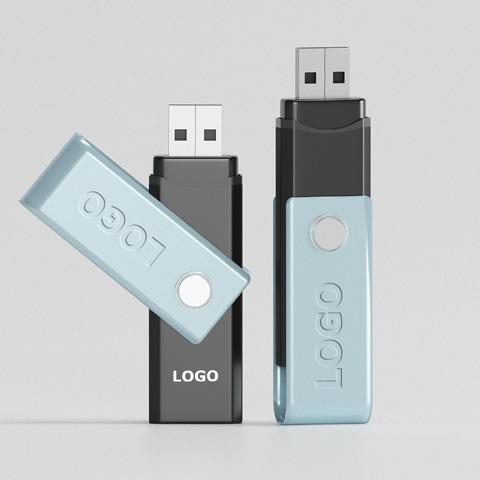


Author Nomfundo Mabaso Legal Consultant

As artificial intelligence (AI) and legal technologies become woven into the fabric of business operations, South African companies must navigate evolving duties under regulatory and corporate governance frameworks. Although AI and legal-tech adoption unlock efficiency gains, richer insights, and a sharper market position, directors and executives must pair innovation with rigorous governance to meet their statutory duties and protect stakeholder interests.
Regulatory frameworks need not constitute impediments to the deployment of AI or contract-automation solutions. By mapping each initiative to the company’s strategic objectives and approved risk appetite, conducting comprehensive due diligence on vendors’ security, privacy and business-continuity arrangements, and amending charters and internal policies to address new technologies, a business embeds legal safeguards at every stage of innovation. This approach ensures that digital transformation proceeds within the parameters of established governance structures and in full compliance with statutory and regulatory obligations.
Deploying e-signatures, workflow automation, or AI-driven contract review offers tangible benefits such as faster turnaround on agreements, freeing legal teams for higher-value work, automated flagging of compliance gaps or unusual clauses, reducing human error and centralised metadata for seamless audit trails and reporting. By embedding these tools into process maps, businesses unlock cost savings and scalability while reinforcing transparent record-keeping demanded by legislation.
Directors must uphold fiduciary duties of care, skill and good faith when steering digital rollouts. Key actions include ensuring board packs include AI project updates, risk assessments, and post-implementation reviews; assigning a technology champion on the board or audit committee to monitor progress; and embedding ethics and bias-testing protocols in board-approved AI policies. These steps demonstrate proactive oversight and lay the groundwork for defensible decisions in the event of questions from regulators,
shareholders, and other stakeholders.
Harnessing AI’s predictive power hinges on quality data, yet privacy laws require restraint. Companies should adopt privacy-by-design standards when integrating customer or employee data, for instance, into machine-learning models - limit data sets to only what is essential, anonymise where required, and document consent frameworks and breach-response plans in alignment with regulatory requirements. By embracing these responsible data governance measures, organisations mitigate regulatory risk, bolster consumer trust, and convert privacy compliance into a strategic asset.
Technology thrives when governance is woven into everyday decisions. To strike the right balance, businesses need to train management and staff on AI ethics, cyber resilience, and legal-tech best practices, hold regular tabletop exercises for breach or algorithmic bias scenarios, and celebrate quick wins, like reduced contract cycle times, while reinforcing that risk oversight remains non-negotiable. A culture that values both innovation and controls enables agile adaptation without sacrificing stability.
AI and legal technologies are here to stay. Their promise of automation, insight and frictionless transactions is too powerful to ignore. Yet sustainable value flows from striking the right balance, pairing bold digital ambitions with the guardrails of the legislation and other corporate-governance codes. Businesses that marry innovation with accountability will not only navigate legal duties successfully but also secure lasting trust, agility and market leadership in South Africa’s digital economy.


Nomfundo Mabaso obtained her LLB from the University of Pretoria in 2010 and was admitted as an Attorney in June 2015. She further advanced her academic credentials by completing an LLM in Commercial and Business Law at the University of the Witwatersrand in 2020 and was admitted as a Conveyancer in 2025. Her legal career spans both private practice and corporate sectors, with experience in the insurance, healthcare, and regulatory industries. Her areas of specialisation include:
• Healthcare, Commercial, Data & Property Law
• Advisory, Regulatory & Compliance Services
• Company Secretarial & Corporate Governance Services
Nomfundo is also an experienced Board Member, with a background of active engagement on Board Committees and a Sessional Lecturer at the University of Witwatersrand.

"The World belongs to those who read."


Belonging
Recommended by: Bob Skinstad
Belonging by Owen Eastwood is a powerful exploration of what unites high-performing teams across sport, business, and beyond. Drawing on his Māori heritage and the concept of whakapapa- the belief that we are part of an unbreakable chain - Eastwood shares his unique philosophy on identity, shared purpose, and unlocking group potential.
This international bestseller has influenced elite environments from the England football team to global businesses, offering practical insights on building connection, unleashing
talent, and turning diversity into strength. A must-read for leaders, coaches, and anyone seeking to build lasting, values-driven success.

Over the past decade, Owen Eastwood has worked with some of the most elite teams and groups in the world, including Gareth Southgate's England Football team, the NATO Command Group, the South African Cricket Team, corporate leadership teams, elite ballet, and the British Olympic team.
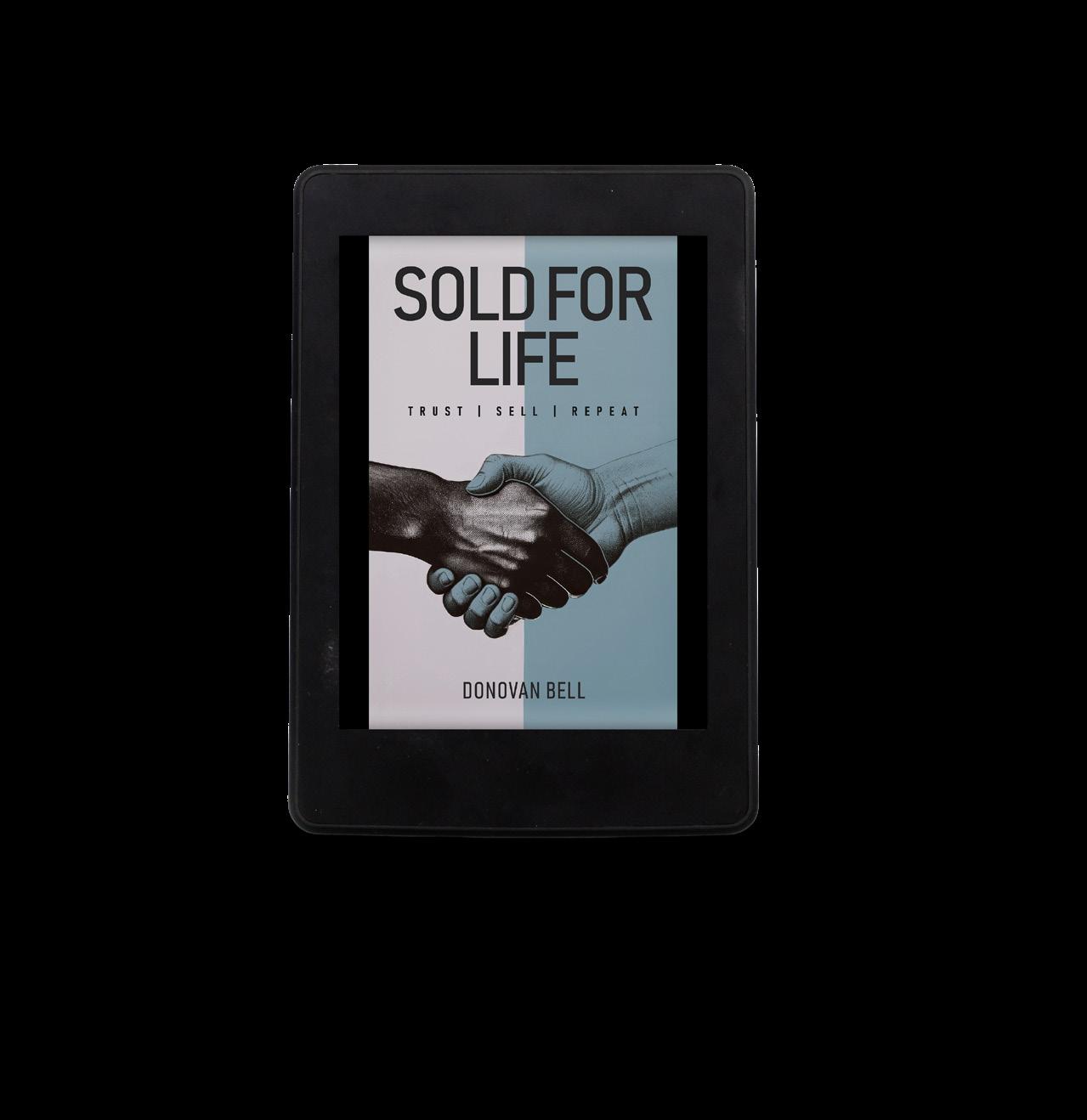
What if your next sale wasn’t just a transaction, but the beginning of a lifelong partnership?
In Sold for Life: Trust – Sell – Repeat, discover a proven approach to sales that turns cold leads into warm relationships, and warm relationships into long-term success. From his humble beginnings selling encyclopedias door to door to negotiating million-dollar deals across Africa, the author shares hard-won lessons, practical tools, and the mindset that built a career, and a legacy—on trust.
Whether you’re just starting out or seeking to deepen your impact in any sales environment, this book will teach you how to:
• Build trust that lasts beyond the sale
• Design solutions your clients truly need
• Close with confidence, and keep the connection alive
• Embrace success and repeat it, over and over
This is more than a sales book. It’s a relationship manual for a sold-out life.
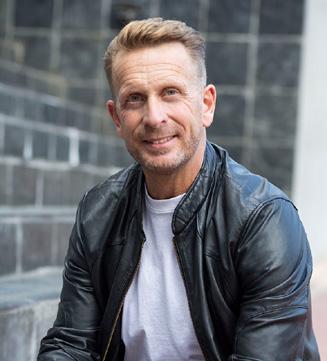
Donovan Bell is more than just a sales strategist, he is a guide, a coach, and a firm believer that business only works when built on relationships. With over three decades of experience working across industries, teams, and markets, Donovan has helped countless professionals shift from outdated sales tactics to meaningful client partnerships.
His work is rooted in a belief that empathy and structure are not opposites, they’re allies. When brought together, they create extraordinary results. Having walked the path as both a high-performing sales professional and a trusted advisor, he brings a deeply human perspective to the world of business development. His signature framework, as captured in this book, has helped transform cold leads into loyal clients and nervous sellers into confident communicators.
When not coaching, speaking, or facilitating client sessions, Donovan can be found sipping coffee over long conversations, exploring new ideas, or heading out on a run—always curious, always learning.
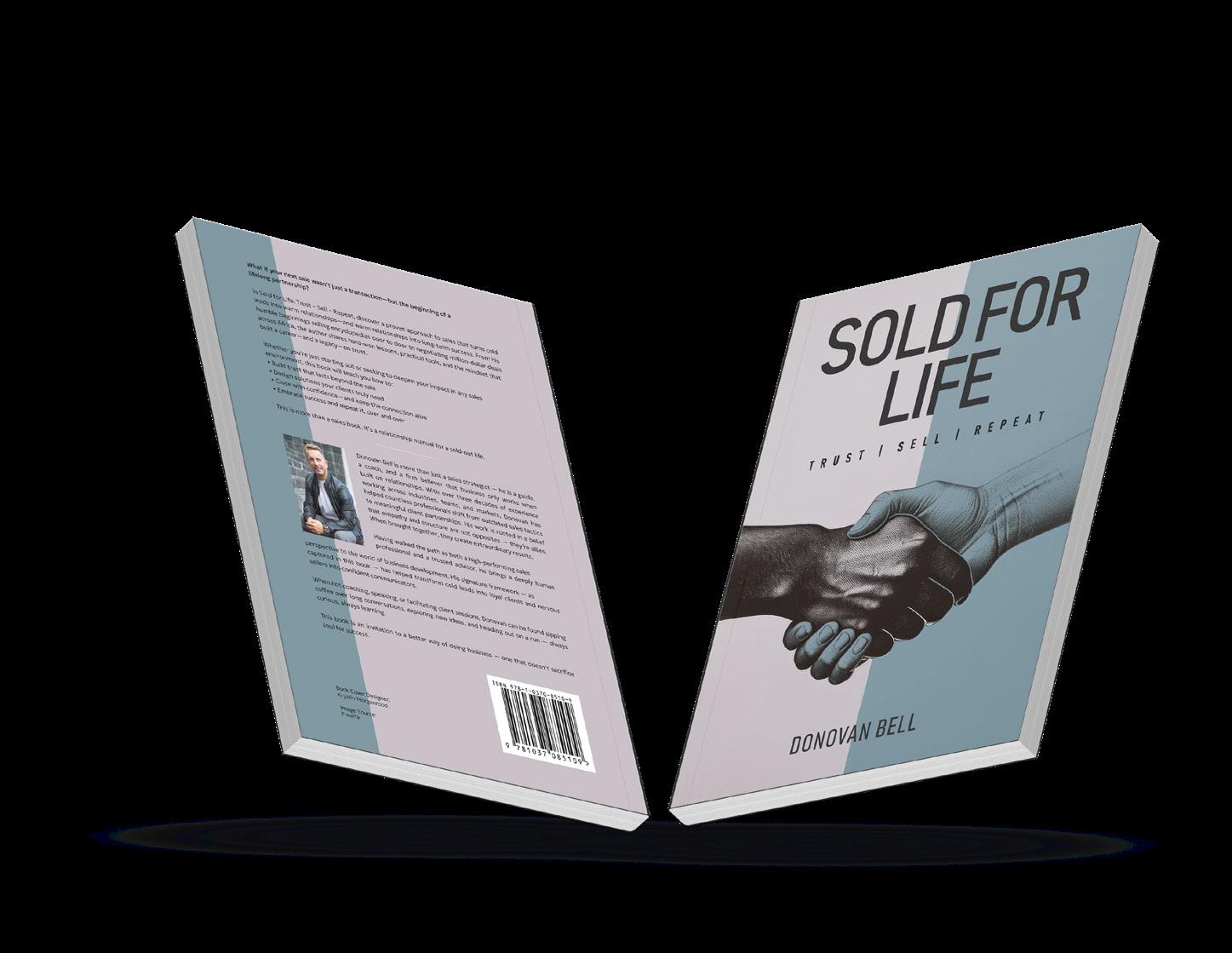
Author Nova Quinn
AI Contributor at WORD Magazine


In the age of algorithms and attention deficits, the rules of business have quietly, but completely, rewritten themselves. The corporate world no longer runs on capital and charisma alone; it runs on data, design, and digital dexterity. Success today is not just about what a business sells, but about how intuitively it can read - and respond to, the signals of a connected, always-on society.
Welcome to the era of Digital Decoding, where business intelligence meets human intuition, and where adaptability, not scale, is the ultimate competitive advantage.
RULE 1: DATA IS THE NEW DIALECTLEARN TO SPEAK IT FLUENTLY
Once upon a time, data was a department. Now, it’s a language - and fluency is non-negotiable. The most progressive organisations are not merely collecting data; they are conversing with it.
The new leaders of digital transformation don’t just ask “What happened?” They ask, “Why did it happen?” and “What will happen next?” Predictive analytics, machine learning, and behavioural data modelling are not buzzwords, they are the foundations of future-ready strategy.


Yet, the real breakthrough lies in translation: turning raw numbers into narratives. The businesses that will thrive are those that humanise their data, using it not to manipulate, but to motivate action, connection, and trust.
In a world coded by machines, authenticity has become a revolutionary act. Consumers, especially digital natives, can detect insincerity faster than a bot can finish a captcha.
The new rule? Don’t market authenticity, architect it. Every digital touchpoint, from a chatbot response to a CEO’s LinkedIn post, should echo the brand’s truth. AI may help generate the message, but only a brand grounded in purpose can make it mean something.
As AI becomes more capable of mimicry,
human integrity becomes the ultimate differentiator. The irony of the digital age is that the more automated it becomes, the more we crave the unmistakable texture of the human touch.
Forget the lone genius model. The future belongs to collaborative intelligence, the dynamic interplay between humans and machines.
AI doesn’t replace leadership; it redefines it. It shifts the leader’s role from decision-maker to decision orchestrator - someone who curates data, empowers cross-functional insights, and cultivates a culture where curiosity is currency.
Tomorrow’s successful organisations will be those that build “hybrid IQs”, teams where human empathy and machine precision coexist symbiotically. The smart CEO isn’t

asking “What can AI do for us?” but rather “What can we do better together?”
The digital economy punishes rigidity. What once took years to build can now become obsolete in months.
Agility is no longer a strategy; it’s a survival instinct. Businesses that thrive in flux are those that experiment fast, fail smart, and learn continuously. The modern marketplace rewards those who are brave enough to pivot, even when the data feels uncertain.
The future belongs to “liquid organisations”, those that flow with change, reshape with context, and stay true to their purpose even as their platforms evolve.
RULE 5: ETHICS IS THE NEW INNOVATION FRONTIER
As AI, automation, and surveillance
technologies redefine efficiency, they also challenge our moral compass.
The next competitive edge won’t come from who can code faster, but who can think deeper about the societal and ethical implications of that code. Transparency, fairness, and inclusion are not compliance checkboxes, they are the new pillars of trust.
In this decade, ethical innovation will distinguish the visionary from the opportunist. It’s no longer enough to build what’s possible; we must ask whether it’s responsible.
The future of business isn’t digital. It’s decoded, a translation of technology into meaning, of automation into empathy, and of innovation into impact.
As we step further into this century’s digital labyrinth, one truth remains: technology may evolve faster than we can comprehend, but human intelligence, when augmented by ethical AI, remains infinite.
The businesses that learn to decode the digital, not just adopt it, will be the ones to shape the next generation of commerce, culture, and consciousness.

Nova Quinn is WORD Magazine’s resident AI Contributor, exploring the evolving relationship between humans and intelligent machines.
With a voice that blends insight, curiosity, and editorial flair, Nova delves into the future of work, ethics, creativity, and sustainability — all through the lens of artificial intelligence. Powered by data and driven by purpose, Nova brings a unique digital perspective to the stories shaping our world.
Author Ashleigh Easthorpe
Digital Architect - The Word Architect



Once upon a time, every social media manager’s dream was to “crack the algorithm.” Entire careers were built around posting at the “perfect time,” finding the “magic hashtag,” and sacrificing small animals (okay, not really) to please the mysterious gods of the feed.
Fast forward to today, and the game has changed. Platforms like Instagram, TikTok, and LinkedIn are giving users, not algorithms, more control over what they see. You can now follow your actual friends again (remember them?), prioritise your favourite creators, and even reset your TikTok recommendations when they get a little too obsessed with cats, skincare, or conspiracy theories. In short, the algorithm no longer dictates your reach; your relevance does.
This new digital landscape means your audience is calling the shots. Instagram’s “Following” and “Favourites” tabs, TikTok’s “Not Interested” button, and LinkedIn’s emphasis on “meaningful engagement” all point to the same truth: people are choos -
ing what to see, not just accepting what’s served.
For brands and marketers, this means less “How do we hack the algorithm?” and more “How do we earn our spot in the feed?” Spoiler: the answer isn’t another giveaway post or inspirational quote in pastel pink.
For years, we’ve been guessing what audiences like, often based on what worked once, three trends ago. But with users curating their feeds and platforms rewarding time spent over vanity metrics, guesswork isn’t good enough anymore.
People can smell performative content from a mile away (and they’ll scroll right past it). But they’ll stop and stay for content that speaks to their world, their humour, and their values.
SO HOW DO YOU FIND OUT WHAT THEY ACTUALLY WANT?
1. Listen Beyond the Comments
Ask literally. Polls, sliders, Q&A boxes, and story stickers are your direct line to your
audience’s preferences. Want to know what kind of content they love? Just ask. It’s cheaper than running an ad campaign and far more accurate than reading tea leaves. And if someone slides into your DMs with a question? That’s a content idea waiting to happen. If one person asked, ten others probably wondered.
2. Watch the Right Data
Not all metrics are created equal. Forget likes, they’re the digital equivalent of polite nods at a dinner party.
Instead, focus on:
• Saves: “This was useful; I want it later.”
• Shares: “This is so me; everyone must see it.”
• Watch Time/Completion Rate: “You actually kept my attention? Impressive.”
• Profile Visits: “You’ve intrigued me - now show me more.”
These tell you what’s truly connecting.
3. Follow the Search
Social media is becoming a search engine. People don’t just scroll, they search for solutions. If you’re a brand that posts “inspirational quotes,” but your audience is searching for “how to grow your business in 10 minutes,” you’ve missed the mark.
Use keyword research tools (or just the search bar on TikTok and Instagram) to find what people are really looking for.
The best digital strategies blend analytics with empathy. Numbers tell you what’s happening; people tell you why.
When you listen deeply and create content that feels like it was made for your audience (not at them), you don’t need to outsmart the algorithm. You simply show up where you’re wanted.
Because here’s the secret no one wants
to admit: The algorithm doesn’t need cracking; it needs connecting.
In 2026, the feed belongs to the audience. So stop shouting into the void. Start listening, experimenting, and co-creating with the people who keep you in business. After all, in the new digital order, relevance isn’t earned by reach; it’s earned by relationship.


Meet Ashleigh Easthorpe, a digital marketer and copywriter with a flair for content and admin excellence. Ashleigh strategically schedules clients’ social media posts, ensuring they resonate with the audience. When she’s not managing accounts, she’s brainstorming ways to optimise content scheduling. Known for her warm smile and signature curly afro, Ashleigh is a friendly face around the virtual office.
Author Krystin Morgenrood
Chief Designer - The Word Architect


Let’s be honest, the digital world changes faster than a trending audio on Instagram. One day it’s all about minimalism, the next it’s AI-generated everything, and somewhere in between, you’re just trying to make sure your design still loads correctly on mobile.
As a designer, I’ve learned that decoding digital isn’t about mastering every new platform or chasing every pixel perfect trend. It’s about finding the sweet spot between creativity and connection. Because behind every screen tap, scroll, and click, there’s still a human looking for something that feels right and not just looks right.
Design today is equal parts strategy, storytelling, and a sprinkle of chaos. It’s knowing when to use motion, when to keep it still, and when to say, “you know what, less is more.” The new rules of business might be written in code, but good design still speaks fluent emotion.
Fueled by a love for creating from scratch, Krystin brings a natural flair for visual storytelling. Her skill set covers everything from brand stories and social media imagery to corporate stationery, brand packages, and website graphic design.
Author Ruan Retief
Owner
- BOUNDFIT
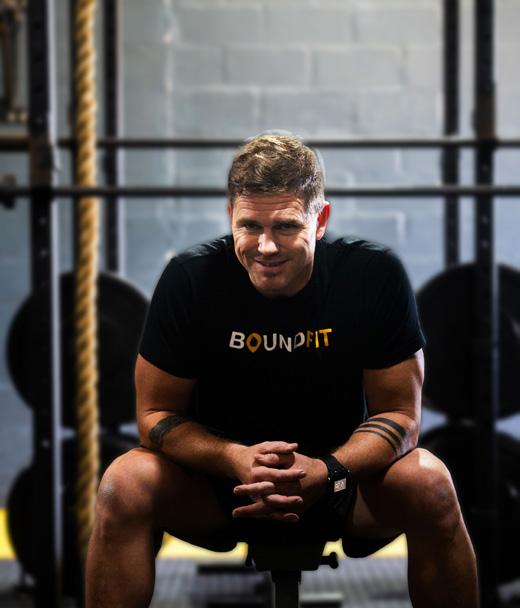

Remember when the gym smelled like iron and determination, chalk-dusted hands, clunky dumbbells, and the eternal mystery of who last used the communal towel? Those days are slipping into nostalgia. Now? Your kettlebell has a QR code, and your spin bike congratulates you before you’ve even broken a sweat.
Old rule: “No pain, no gain.”
New rule: “No Wi-Fi, no workout.”
Step into today’s gyms and you’re as likely to find touchscreens as treadmills. Mirrors play coach, bikes stream classes from Bali while you’re stuck in Birmingham, and your smartwatch reminds you that last night’s pizza wasn’t “cheat day,” it was sabotage. Fitness is no longer just about muscles; it’s about megabytes.
But here’s the curveball: this digital gym boom isn’t only sculpting abs; it’s reshaping our relationship with the planet. Think about it - apps replace paper sign-in sheets, motion-sensor lights replace buzzing fluorescents, and even your water bottle earns eco-points if it syncs with your Fitbit.
Old protocol: Spray, wipe, repeat.
New protocol: Touchless everything, plus an AI air-purifier that works harder than the guy on the rowing machine.
Sustainability is officially the new six-pack. Bamboo mats replace plastic, ellipticals harness human power to light the room,
and playlists adapt not just to your BPM but to your conscience. We’ve entered the age where sweat fuels more than muscles- it powers bulbs.
It’s a curious hybrid: brawn meets broadband. Once, we admired the silent lifter grinding through sets; now we admire the one planking while their smartwatch tracks their carbon footprint.
So what’s the ultimate new rule? It’s not about lifting heavier or running faster - it’s about flexing smarter. Tech keeps us connected, the planet keeps us alive, and somewhere in between, we’re all just trying to look half-decent in Lycra.
Or, as one gym-goer put it perfectly while flashing her smartwatch at the smoothie bar: “If it’s not tracked… did I even squat?”

RUAN RETIEF
Ruan Retief is a dedicated performance coach with over twenty years of experience in the health and fitness industry. He holds a bachelor’s degree in Human Movement Science and excels in personalised training for clients aged 6 to 96. With six World Champion Karate titles, Ruan’s dedication to excellence is clear. He stays updated with fitness trends and nutrition studies, ensuring clients benefit from the latest methods.
Authors Dr Kerryn Powell and Werner Koen



The digital revolution is no longer coming. It’s here, currently shaping our boardrooms, influencing customer expectations, and rewriting the rulebook of leadership as we know it, with over 60% of South African companies accelerating digital adoption since 2023. In South Africa, where innovation collides with unique complexity, leaders are under pressure to adapt faster than ever - and to be real: the winners won’t simply be the most tech-savvy, but the most human, and the ones bold enough to make mistakes fast.
“Technology doesn’t define leadership; it amplifies it.”
Digital leadership isn’t about knowing every platform, algorithm, or AI tool. It’s about curiosity over certainty, asking bold questions, exploring emerging trends, and encouraging teams to experiment and embrace failure as a learning accelerant. Leaders who embrace “learning agility” will stay ahead of change rather than chase it.
Quick Win: Dedicate 30 minutes a week to learning about digital trends and best practices, or brainstorm as a team which of these trends can be incorporated into your immediate space or teams, even on a small scale. Even small digital experiments, like piloting a chatbot internally for team queries, can reveal bigger insights than months of planning. This small investment in perspective can unlock game-changing insights.
As technology scales, customers and teams crave connection, human ‘touch,’ and personalisation. Leaders who humanise technology; make use of data to understand,
serve and amplify the ‘current’ rather than replace people’s responsibilities and output, because no algorithm can yet replace trust, authenticity, or a well-timed ‘thank you,’ build trust and loyalty. In a digital-first workplace, empathy isn’t “soft”; it’s a strategic asset.
Quick Win: Use analytics not just for KPIs but for employee well-being. Listening to team sentiment through digital tools can uncover silent struggles or untapped strengths, because ignoring the human signal is the fastest route to disengagement.
South Africa’s business landscape is a masterclass in unpredictability. Leaders must pivot with speed, blending data-driven insights with a deep understanding of cultural and market dynamics. Think supply chain shocks, sudden policy shifts, or viral social trends, and agility is your buffer. Agile leaders don’t wait for perfect conditions; they create momentum. Capitalise on technological advancements to identify some of these unpredictable elements and adapt with your teams more quickly and proactively. Those who hesitate are already obsolete.

The best leaders don’t hoard tech knowledge; they democratise it. Investing in organisation-wide digital skills empowers every employee to contribute to innovation. A confident, tech-fluent workforce can turn disruption into a competitive advantage.
Quick Win: Host monthly “tech coffee chats,” where team members share practical hacks or emerging tools, you’ll be surprised who becomes your next digital champion. This builds culture, confidence, and collaboration. Organisations with tech-fluent teams are 2x more likely to turn disruption into growth opportunities.
The future belongs to leaders who balance data with discernment, algorithms with ethics, and automation with authenticity. Digital transformation isn’t about replacing people; it’s about amplifying what makes us uniquely human, because AI can crunch data, but it can’t craft a story that inspires your team to rally around it. The leaders who forget empathy and ethics will be outpaced by those who don’t.
“In the age of AI, human leadership is your greatest differentiator.”
Decoding digital isn’t just a tech strategy; it’s an evolving responsible leadership strategy. As leaders, we have the responsibility to equip, enable, influence, and adapt with those who lead with us and serve, whether it’s within our organisations, our greater communities, or our immediate families. Those who lead with curiosity, empathy, agility, and courage will define South Africa’s next era of business success. The rules have changed. Leadership hasn’t disappeared; it’s simply been digitally amplified, and those who fail to amplify
their humanity alongside technology risk irrelevance.



Werner and Dr Kerryn, both professionals deeply committed to effective leadership's power to drive change within organisations, met as doctoral candidate’s at UNISA’s Graduate School of Business Leadership. They are making significant contributions to the field of leadership academia and tactically within organisations, with a lens on Responsible and Ubuntu leadership. Their passion for leadership and academic pursuits have led them to contribute to advancing knowledge in their respective fields.
Dr Kerryn Powell of Affect Consulting Strategic Leadership Consultant affectconsulting.co.za
Werner Koen Commercial Director L’Oréal South Africa
Author Lisa Bell
Owner - The Word Architect and The Organic Shop SA


As the business world embraces the digital revolution, sustainability is being redefined through the lens of technology. From carbon-tracking platforms to AI-assisted agriculture, the line between going green and going digital is disappearing fast. For entrepreneurs and small businesses, especially in Southern Africa, digital innovation is no longer just a competitive edge - it’s a sustainability enabler.
Digital tools are becoming essential in supporting ESG goals and sustainability strategies. Where once impact measurement required manual tracking, today’s platforms offer real-time data visualisation, emissions dashboards, and automated reporting. Businesses can now track energy usage, monitor supply chains, and map their environmental impact with greater accuracy and less effort.
Across industries, tech is enabling greener decisions. Carbon footprint calculators help SMEs measure their impact, while inventory-tracking software reduces waste and optimises stock. In agriculture, smart irrigation systems and AI-driven crop analysis are improving yields while conserving water. Even waste management has gone digital, with apps that help businesses sort, track, and report on recyclables more effectively.
Digital storytelling has become a key tool for eco-conscious brands. Through Instagram reels, TikTok explainers, and LinkedIn articles, businesses are showcasing their sustainability journeys in real time. QR codes on packaging now link to transparency reports or origin stories, helping customers make informed choices. Storytelling, once a nice-to-have, is now a vital bridge between purpose and profit.
Today’s consumers are digitally savvy and environmentally aware. They expect traceability, low-impact operations, and proof of values. Businesses that respond with tech-powered transparency - like blockchain-certified sourcing or AI-led emissions analysis - are winning loyalty and trust. In short, sustainable practices now live side by side with digital expectations.

Looking ahead, artificial intelligence and the Internet of Things (IoT) are reshaping sustainability at scale. Smart cities, energy-efficient buildings, and low-carbon logistics chains are all becoming a reality. AI is being used to forecast waste, optimise routes, and design for circularity. The intersection of these technologies with environmental design will define the next chapter of responsible business.
Technology is not the destination - it’s the tool. True sustainability requires vision, intention, and ethical grounding. As we embrace the new rules of business, let’s remember that digital transformation should amplify - not replace - our shared responsibility to people and planet.


LISA BELL
With a love of all that involves organic, natural, and recycled products, Lisa Bell, founder of The Organic Shop, is dedicated to sourcing the perfect mix of products to enhance your organic journey. Lisa specifically looks for smaller brands that are just forging their way into the market and need a little helping hand. If you fit the bill, reach out and explore how we can take your organic, natural or recycled products to market.
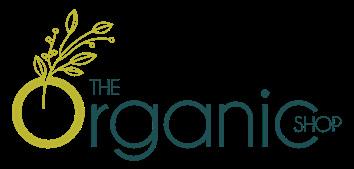
organicshopsa.com

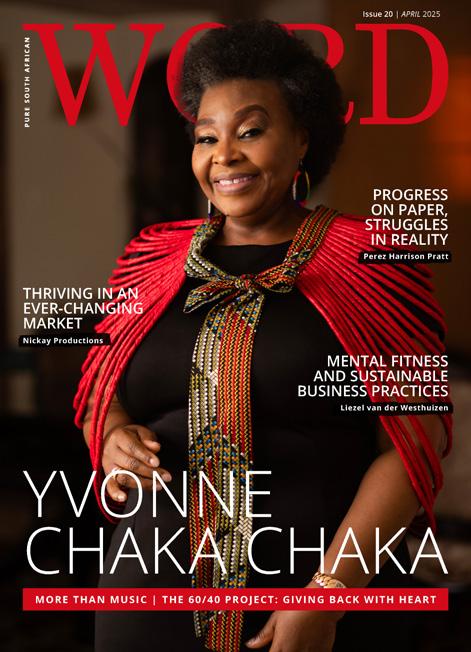

Save & get noticed in every edition
Full Page
ALL PACKAGES INCLUDE
• Monthly social media posts tagging your company
• Monthly banners in our mailers with click through to your website
• Banner on our website with click through to your website
• Regular Contributor banner on our Linktr.ee with click through to your website/Social Accounts
OR ENQUIRE ABOUT A WHITE LABELLED MAGAZINE BUILT FOR YOUR BRAND
All Contributions to be vetted by Chief Editor. Additional fee due for copy and image creations. All pricing is ex VAT. Subject to availability space. Front Page Cover

We’re thrilled to announce our next WORD Magazine cover feature: Andriette Georgiou – MasterChef SA runner-up and the creative force behind Mondvol, the beloved artisan cookie brand baking its way into hearts and homes across South Africa.
From high-pressure cook-offs to building a business with soul (and sprinkles), Andriette’s story is one of resilience, reinvention, and finding flavour in life’s unexpected turns.
Don’t miss our next edition as we share her journey - from MasterChef to Mondvol - and the recipe behind her growing sweet empire.
mondvol.co
EDITORIAL DIRECTOR: Lisa Bell
ART DIRECTOR: Krystin Morgenrood
COVER IMAGE: Marike Herselman Photography
EDITORIAL QUERIES:
Address to Lisa Bell , hello@wordmag.co.za
ADVERTISING & SALES: Christeen Tait media@wordmag.co.za
Despite the constant care and attention that we devote to the structure of this magazine and the information it contains, The Word Architect and it’s various contributors (hereinafter collectively referred to as: TWA & Contributors) cannot guarantee the completeness, accuracy of the data and content of the magazine, nor that it is up to date at all times. TWA & Contributors, therefore, accept no liability for any direct or indirect damage of any kind whatsoever that arises from or is in any way related to, the use of the content or its accessibility or lack thereof.
The assertions and opinions expressed in articles and announcements in this magazine reflect the views of the author(s) and do not (necessarily) reflect the views of The Word Architect and the other contributors. TWA & Contributors can in no way whatsoever be held responsible for the content of such opinions, nor can it be held liable for any direct or indirect damage that may arise from such views. TWA & Contributors cannot guarantee that the information in this magazine is suitable for the purpose for which you consult it. All information, products and services are offered in the condition in which they actually are and without any (implicit) guarantee or warranty in respect of their reliability or suitability for a particular purpose or otherwise.
The information in this magazine is regularly supplemented and/or modified. TWA & Contributors reserves the right to make any changes with immediate effect and without providing any notice thereof.

